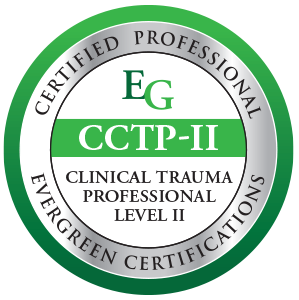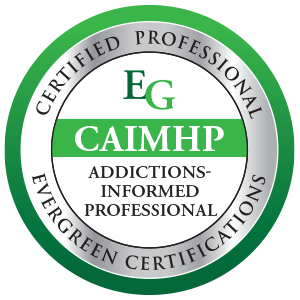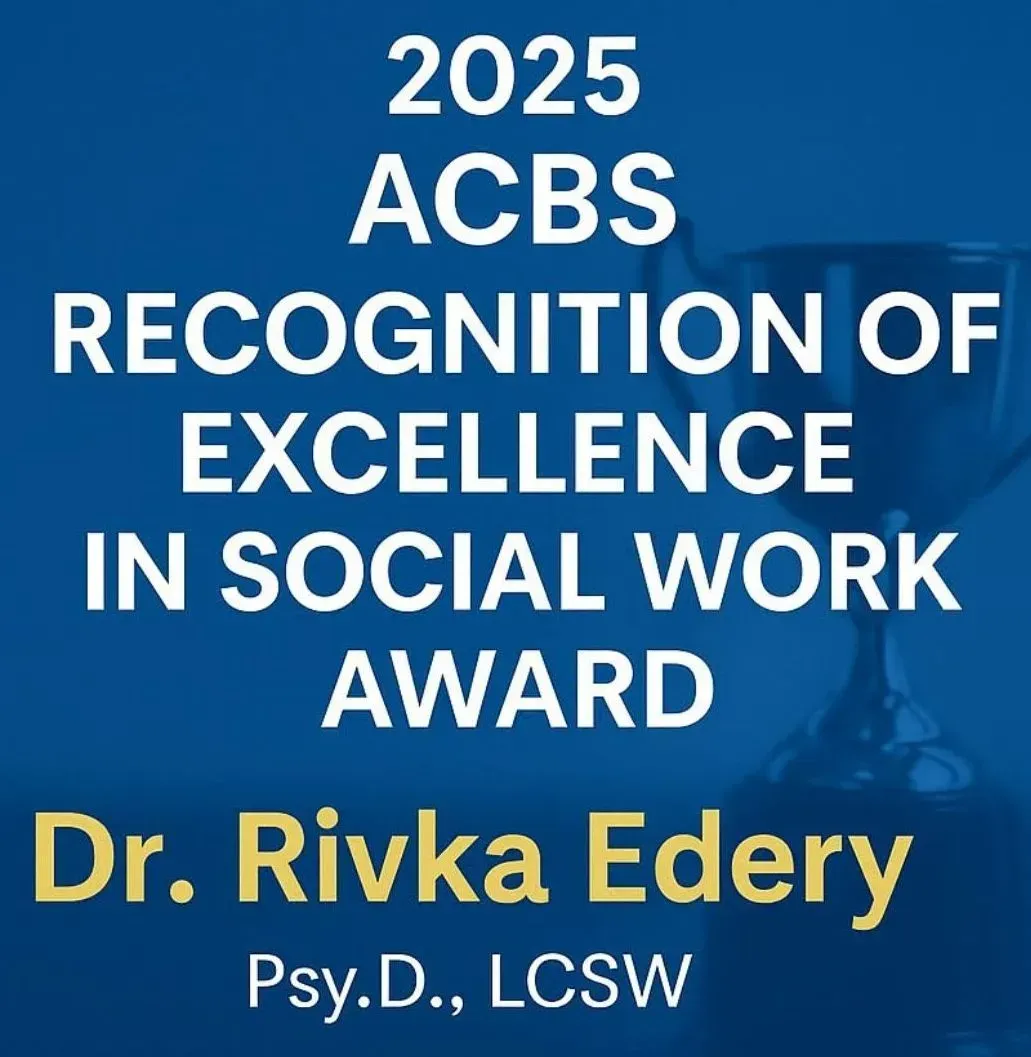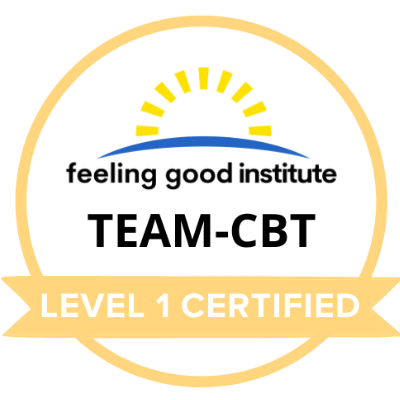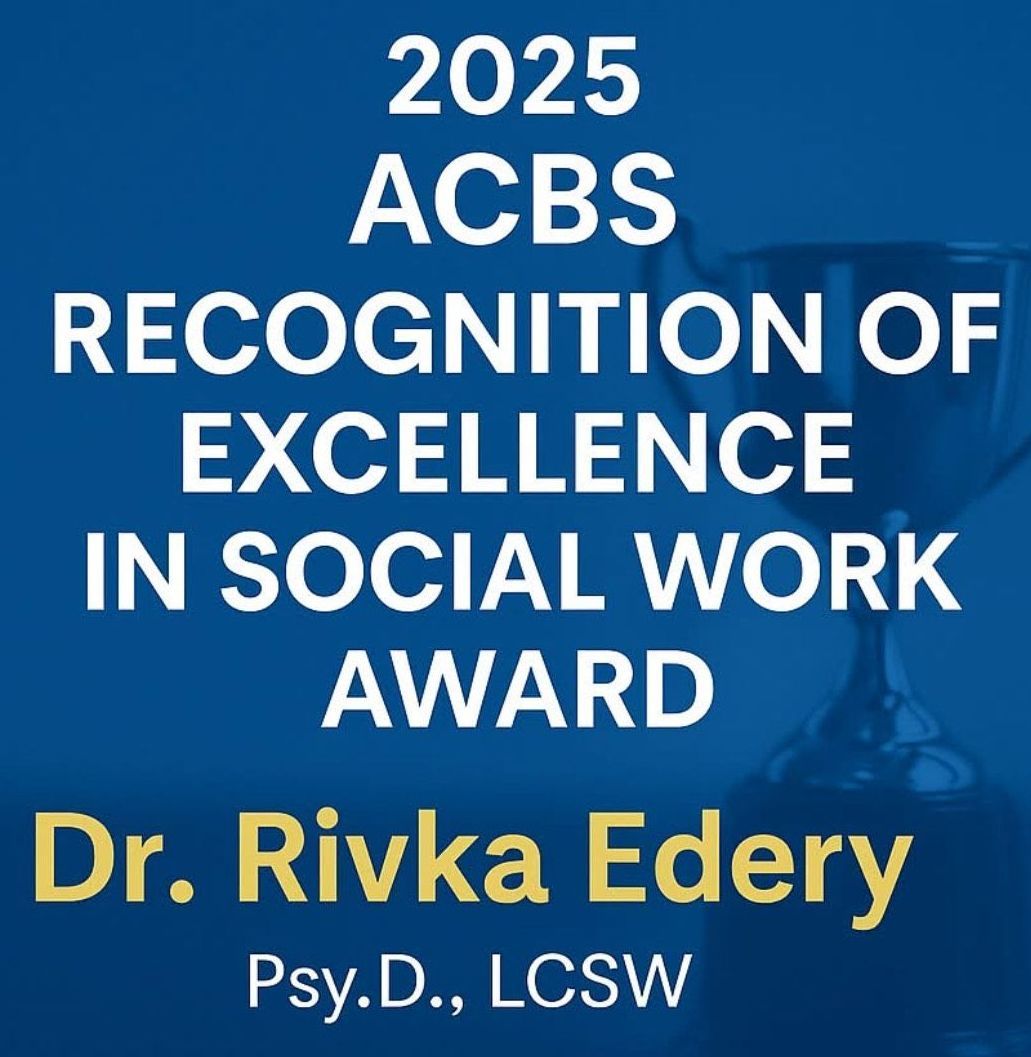
Congratulations to Dr. Rivka Edery, Psy.D., LCSW, recipient of the 2025 ACBS Recognition of Excellence in Social Work Award! Dr. Edery is a clinician, educator, and author whose integrative framework—the U-Model™—blends Internal Family Systems (IFS) with Acceptance and Commitment Therapy (ACT) to support healing through values-based action. Her contributions to trauma-informed practice and clinical training have reached hundreds of clinicians and caregivers. We’re proud to recognize Dr. Edery’s leadership in advancing contextual behavioral science in social work.
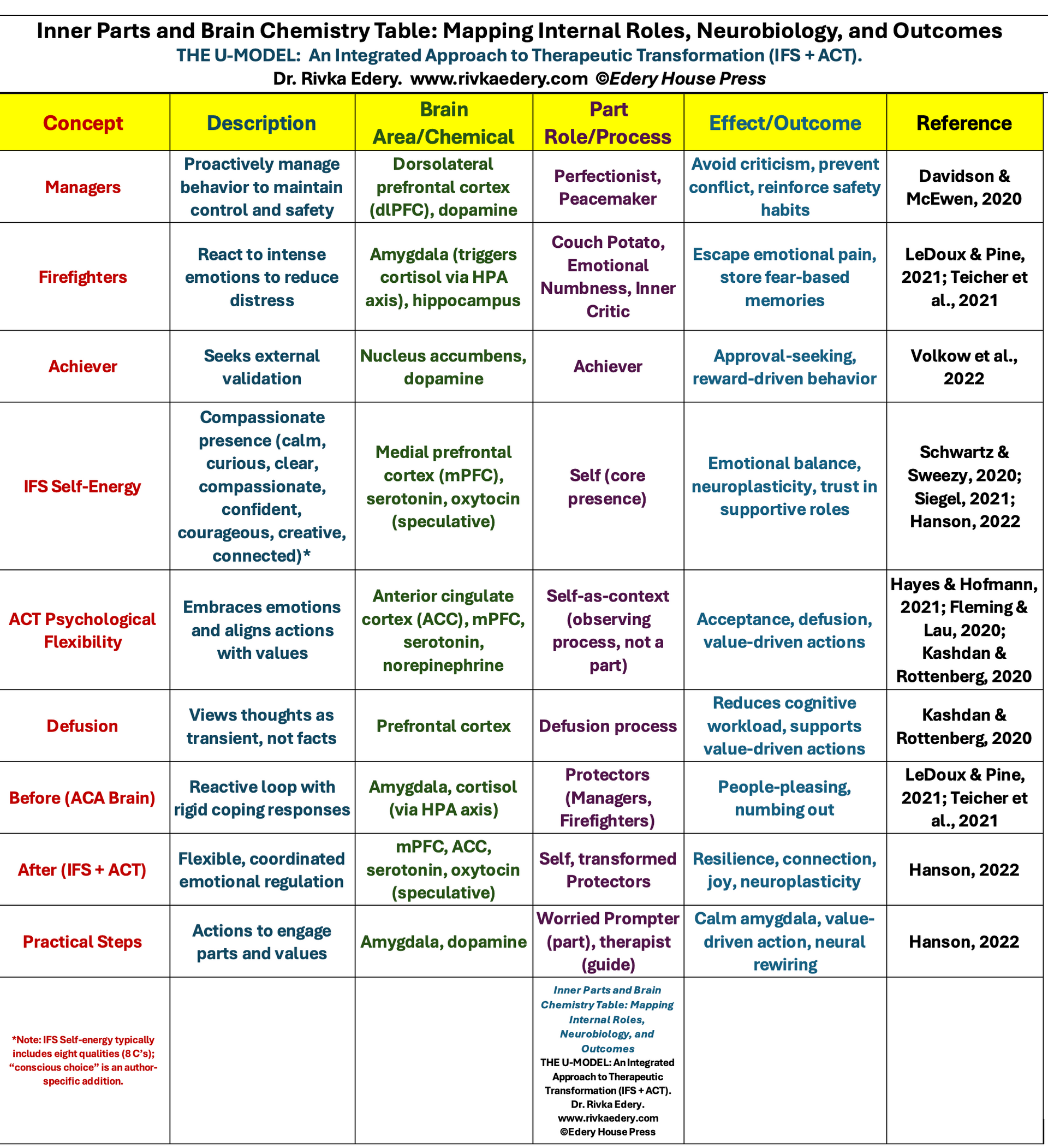
Based on my U-Model™, this post, "Rewire Your Mind's Stage: A Playful Path to Healing with IFS and ACT for Young ACA Souls" blends Internal Family Systems (IFS), Acceptance & Commitment Therapy (ACT), and neuroscience to empower Adult Children of Alcoholics (ACA) to transform chaos into a values-led life.
What makes it unique? It connects:
- IFS: Compassion to understand your inner “parts.”
- ACT: Flexibility to pursue what matters.
- Neuroscience: How your brain rewires for healing.
Not just theory—it’s a practical guide to direct your own life’s stage! Includes a Chart mapping inner protectors to brain chemistry, a Glossary to decode the science, and resources like IFS/ACT communities and meditation tools.
Read now: https://www.rivkaedery.com/blog283558fa
Instant download from Google Drive:
https://drive.google.com/file/d/1g9s0lY-VFYQ8uBpc9Ir6tZAX_gGzXtjE/view?usp=drive_link
IMAGE: Inner Parts and Brain Chemistry Table: Mapping Internal Roles, Neurobiology, and Outcomes
THE U-MODEL™: An Integrated Approach to Therapeutic Transformation (IFS + ACT).
Dr. Rivka Edery. www.rivkaedery.com ©Edery House Press
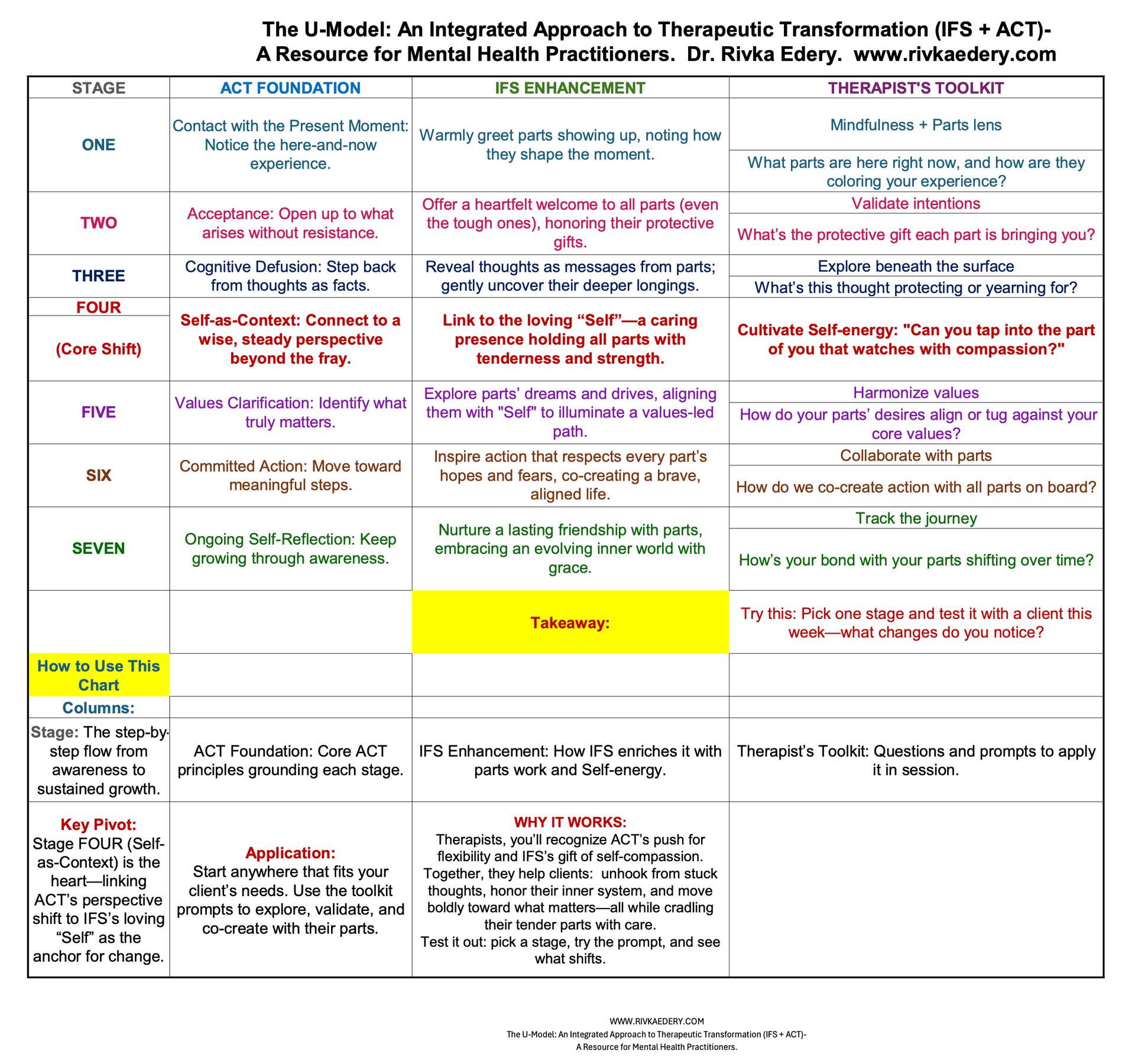
The U-Model™: An Integrated Approach to Therapeutic Transformation (IFS + ACT)
The U-Model is a personal invitation to a front row seat to your mental stage. On this stage, is where the constellation of your inner family parts, are the true governors of your mind!
Combining two powerhouses of theoretical and clinical approaches, IFS and ACT, the stagecraft can be seen as your brain’s operating theater. A theater which hosts a family of parts each with their own assigned duties, strengths and weaknesses. The center stage is occupied by the usual case of dominant, protective characters, while the exiles are deliberately and actively hidden away.
ACT offers you the golden ticket to see the mind’s intricate workings, with the added bonus of hidden governing rules. Combining a deep understanding with strength and gentleness, you observe the drama with a smile. Using flexibility, you bypass parts’ obstacles, without interrupting their performance.
Your authentic Self is the magnetic, creative Director shining its energy on the entire family of parts. The brilliance of self Energy lies in its values-based leadership. A combination of heroic release and spiritual elegance. Psychological flexibility, values-based living, and the active observer position are the elixir for your burdened parts to release their burdens.
Your mind, perhaps once riddled with inflexibility, becomes the place where your mind can discover values-based meaning, and go forth in making those come alive!
Ready to try it? Choose any stage to test the prompts and observe the transformation.
Visit rivkaedery.com to learn more.
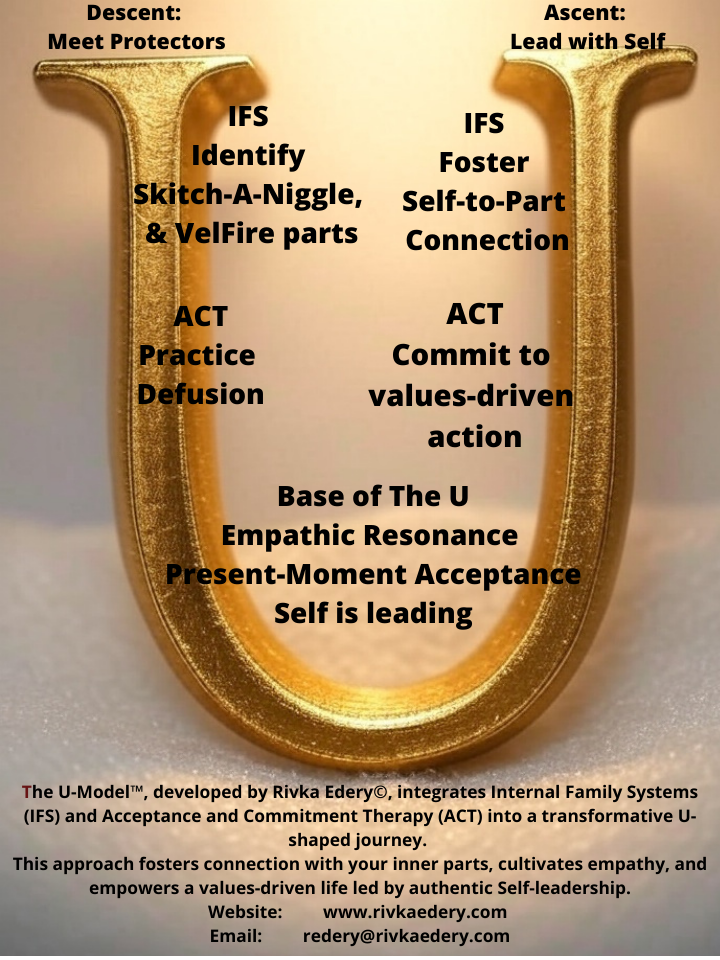
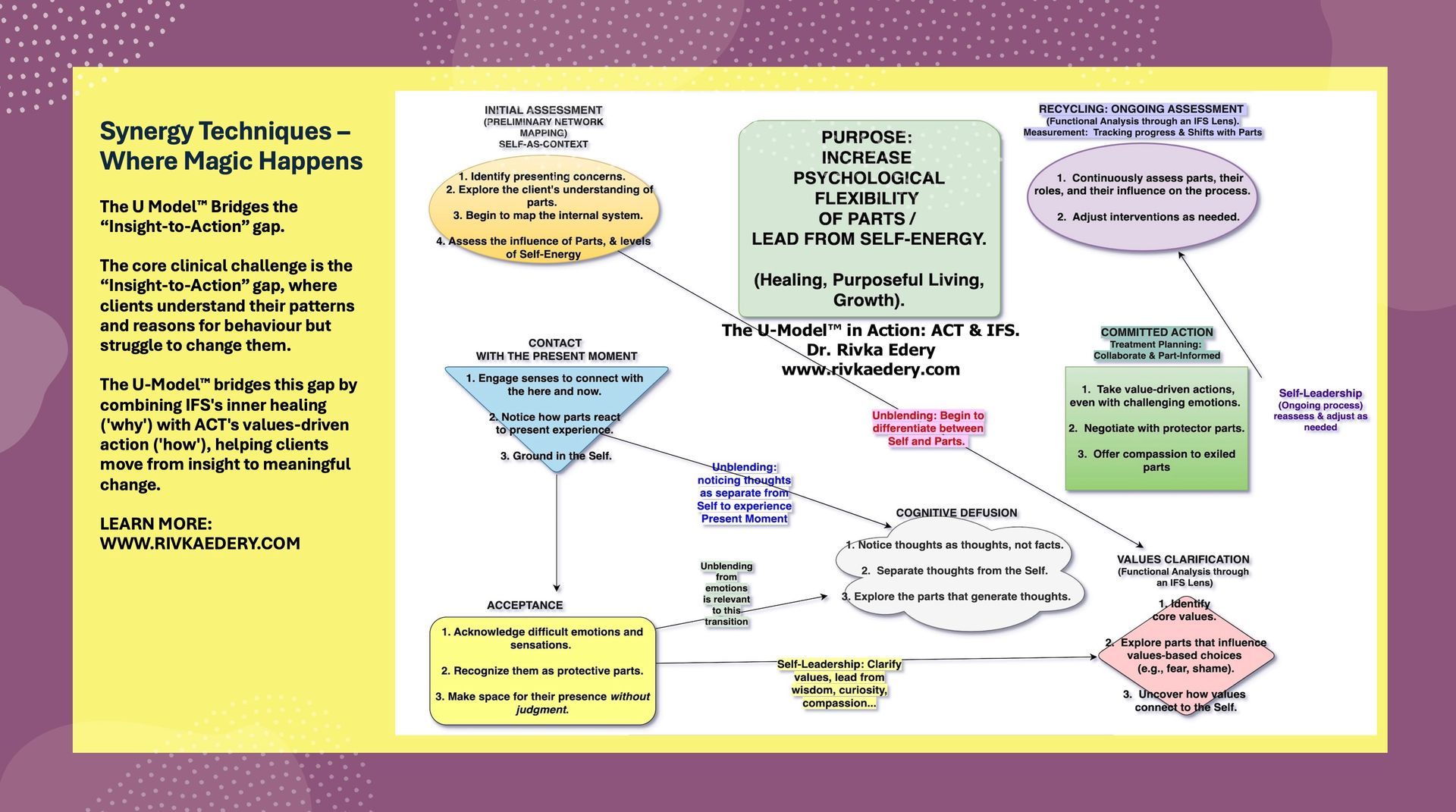
The U-Model™: A Framework for Integrating ACT & IFS.
Bridging the "Insight-to-Action" gap.
Developed by the author, Dr. Rivka Edery, the U-Model™ integrates Internal Family Systems (IFS) and Acceptance and Commitment Therapy (ACT).
The U-Model's 7-stage roadmap is divided into two arcs:
Descent (Inner Depth – IFS Focus):
1) Initial Assessment
2) Present Moment Contact
3) Acceptance
4) Defusion & Unblending
Ascent (Outer Action – ACT Focus):
5) Values Clarification
6) Committed Action
7) Recycling (Loop Back)
The core clinical challenge is the "Insight-to-Action" gap, where clients understand their patterns and reasons for behaviour but struggle to change them. The U-Model™ bridges this gap by combining IFS's inner healing ('why') with ACT's values-driven action ('how'), helping clients move from insight to meaningful change.
This structure guides clients from inner exploration to values-driven action.
FOUR EXAMPLES:
1) Defusion + Unblending (Stage 4):
ACT helps clients see thoughts as passing clouds ('I'm worthless'), while IFS identifies the 'Critic' part behind the thought and thanks it for its protective role.
2) Values + Parts Needs (Stage 5):
ACT clarifies a value such as 'Connection,' while IFS reveals a Manager part blocking connection to protect a fearful Exile. The part is then reframed as seeking 'Safe connection.'
3) Acceptance + Self-Compassion (Stage 3):
ACT: Encourages clients to accept their feelings without judgment.
IFS: Helps clients connect with their Self, which is inherently compassionate, to soothe and understand their parts.
4) Committed Action + Manager Collaboration (Stage 6):
ACT: Focuses on taking committed actions that align with one's values.
IFS: Engages managers to collaborate and support these actions, ensuring that the steps taken are sustainable and protective of vulnerable parts (exiles).
The U-Model™: An Integrated Approach to Therapeutic Transformation (IFS + ACT)
A Resource for Mental Health Practitioners
Dr. Rivka Edery
www.rivkaedery.com Email: redery@rivkaedery.com
Credit: Dr. Richard Schwartz, IFS Founder
Dr. Steven Hayes, ACT Founder
Internal Family Systems Institute (IFSI)
Association for Contextual Behavioral Science (ACBS)
Introduction
The U-Model™ is an innovative therapeutic framework that integrates the profound insights of Internal Family Systems (IFS) with the empowering strategies of Acceptance and Commitment Therapy (ACT). This synergistic approach, visualized as a "U" shape, guides clients through deep self-exploration and empowers them to live a more fulfilling life aligned with their values.
What is IFS?
Internal Family Systems (IFS) is a therapeutic model that views the psyche as comprised of various "parts," each with its own unique perspectives, emotions, and intentions. IFS emphasizes compassion and understanding for all parts, even those that seem problematic, recognizing that they have positive intentions.
How IFS Differs
Unlike traditional therapeutic approaches that focus on the individual as a single entity, IFS recognizes the internal complexity of the human psyche. It shifts the focus from eliminating or controlling "symptoms" to understanding and befriending the internal system.
What is ACT?
Acceptance and Commitment Therapy (ACT) is a therapeutic approach that cultivates psychological flexibility. ACT helps individuals develop skills to manage difficult emotions, detach from unhelpful thoughts, and live a life guided by their values.
How ACT Differs
ACT distinguishes itself from traditional cognitive-behavioral therapies (CBT) by focusing on acceptance and mindfulness rather than challenging or changing thoughts. It emphasizes the importance of values-driven behavior and psychological flexibility.
The U-Model: A Journey of Self-Discovery
The U-Model's seven stages are mapped onto the core processes of ACT's Hexaflex model (a change-process 'grid'), creating a comprehensive roadmap for facilitating deep and lasting change. This journey fosters profound personal growth by honoring the principles of both IFS and ACT.
The Seven Stages of Transformation
ONE: Contact with the Present Moment (ACT): Guide clients to connect with the present moment through mindfulness techniques. Enhance awareness of their internal experiences (thoughts, emotions, sensations) and how different parts react to the present.
IFS Integration: Help clients notice which parts are most prominent in the present moment and how they influence their experience.
TWO: Acceptance (ACT): Facilitate the development of acceptance towards difficult emotions and thoughts. Guide clients to recognize these as protective responses with valuable intentions, fostering self-compassion and reducing internal conflict.
IFS Integration: Help clients extend acceptance to all parts, even those that seem disruptive or cause distress.
THREE: Cognitive Defusion (ACT): Introduce techniques to help clients detach from their thoughts' literal content. Explore the underlying needs and beliefs that fuel these thoughts, creating space for greater psychological flexibility.
IFS Integration: Help clients understand that thoughts are generated by parts, and defusing from thoughts allows for greater clarity in understanding the needs of those parts.
FOUR: Self-as-Context (ACT): Guide clients to experience themselves as the observing self, separate from the content of their thoughts and emotions. Cultivate a sense of spaciousness and perspective.
IFS Integration: Connect this to the concept of "Self" in IFS, the core of wisdom and compassion that can observe and interact with parts.
FIVE: Values Clarification (ACT): Guide clients through a process of values clarification. Help them identify their core values, explore how different parts influence their choices, and connect with the wisdom of their "Self" to align with these values.
IFS Integration: Explore how different parts might hold different values or have various ways of pursuing values. Help clients find alignment between their parts and their core values.
SIX: Committed Action (ACT): Support clients in translating their values into meaningful action. Help them negotiate with protective parts, offer compassion to vulnerable parts, and cultivate the courage to move forward.
IFS Integration: Encourage clients to take actions that honor the needs and concerns of all parties as they strive to live values-driven lives.
SEVEN: Ongoing Self-Reflection (ACT & IFS): Foster a continuous process of self-discovery. Encourage clients to deepen their awareness, refine their understanding of their inner world, and remain open to new insights as they evolve.
IFS Integration: Support clients in developing an ongoing relationship with their parts, recognizing that the internal system is dynamic and ever-evolving.
The Synergy of IFS and ACT
Internal Family Systems (IFS) offers a compassionate framework for understanding the client's inner world, recognizing that all parts, even those seemingly problematic, have positive intentions. Acceptance and Commitment Therapy (ACT) provides practical tools for cultivating psychological flexibility, managing difficult emotions, and living a values-driven life.
The U-Model™ in Practice: A Case Example
Consider a client, Sarah, presenting with social anxiety in professional settings. The U-Model guides the therapist to:
Identify the "parts" involved: Through guided inquiry, Sarah identifies a "Worrier" part that anticipates negative judgments and a "Perfectionist" part that fears making mistakes.
Cultivate compassion for these parts: Sarah explores the origins of these parts, recognizing that the Worrier is trying to protect her from social rejection and the Perfectionist is trying to help her succeed.
Utilize ACT techniques to manage anxiety: Sarah learns mindfulness techniques to ground herself in the present moment during social interactions. She also practices cognitive defusion techniques, such as the "name your story" technique, where she labels her anxious thoughts as "the performance anxiety story," creating distance and reducing their impact.
Take values-driven actions: Sarah clarifies her values, identifying meaningful connections and professional growth as necessary. She then experiments with taking small steps toward these values, such as initiating conversations with colleagues and sharing her ideas in meetings. She also offers compassion to her Worrier and Perfectionist parts as they react.
Benefits for Clients
- Self-discovery cultivates a profound understanding of one's inner world, including thoughts, emotions, and sensations, leading to greater self-awareness and acceptance.
- Emotional Mastery develops effective emotional regulation and management skills by learning to identify, understand, and navigate emotions healthily. This reduces emotional reactivity and increases resilience.
- Relationship Enhancement: This approach improves relationships by fostering a deeper understanding of self and others, empathy, compassion, and effective communication.
- Trauma Healing: Provides a safe and practical framework for addressing and resolving trauma by recognizing and working with the different parts involved in the trauma response.
- Resilience Building: Fosters resilience and the ability to navigate challenges with greater ease by developing skills in emotional regulation, self-compassion, and values-driven action.
- Personal Growth: Supports personal growth and developing a more fulfilling life by aligning actions with values and fostering self-acceptance.
Benefits for Therapists
Integrated Framework: This framework offers a clear, structured, and integrated approach to utilizing IFS and ACT principles, providing a comprehensive roadmap for therapy.- Enhanced Therapeutic Effectiveness: This provides a roadmap for addressing complex client needs, enhancing therapeutic approaches, and facilitating more profound, meaningful change.
- Versatile Application: Adaptable to various mental health concerns, increasing therapeutic reach and effectiveness across diverse client populations.
- Client Empowerment: Encourages clients to actively participate in their healing journey, fostering autonomy and self-efficacy.
- Improved Outcomes: Addressing the root causes of psychological distress and promoting self-compassion facilitate lasting change and improve client therapeutic outcomes.
Practical Exercises
- Parts Mapping: Draw a visual representation of your internal system, including the different parts and their roles.
- Mindful Breathing: Practice mindful breathing exercises to connect with the present moment and observe your internal experience.
- Values Exploration: Write a journal entry reflecting on your core values and how they guide your actions.
- Cognitive Defusion Practice: Use techniques like the "name your story" technique or the "leaves on a stream" metaphor to practice detaching from unhelpful thoughts.
Potential Challenges and How to Navigate Them
Resistance from Parts: Some parts may resist the therapeutic process. The therapist can help clients negotiate with these parts, validate their concerns, and offer compassion.
Intense Emotions: As clients explore their internal systems, they may experience intense emotions. The therapist can provide a safe and supportive space for processing these emotions and teach grounding techniques.
Difficulty Identifying Parts: Some clients may need help to identify their parts. The therapist can use guided imagery, role-playing, or other experiential exercises to help clients access their internal world.
Finding a U-Model Therapist
While the U-Model is a relatively new approach, many therapists incorporate it. Dr. Rivka Graham-Edery, the model's developer, offers workshops and training for therapists interested in learning more about the U-Model. For more information, email: redery@rivkaedery.com
Finding Therapists Trained in IFS and ACT
Since the U-Model integrates IFS and ACT, seeking therapists with expertise in these foundational approaches can also be beneficial. Here are some resources to help you find therapists trained in IFS and ACT:
Internal Family Systems Institute (IFSI): https://ifs-institute.com/
Association for Contextual Behavioral Science (ACBS): https://contextualscience.org/
Conclusion
The U-Model is a powerful transformation tool that integrates the strengths of IFS and ACT to facilitate profound and lasting change in clients. This collaborative, process-based approach fosters deep self-understanding, cultivates self-compassion, and promotes a life of greater authenticity, courage, and inner wholeness. By understanding their internal system, clients can develop skills to manage difficult emotions, clarify their values, and commit to a more fulfilling life.
Call to Action
If you want to learn more about the U-Model, please download this handout and explore its transformative potential in your practice.
https://drive.google.com/file/d/1AS5Y7rDXmnlZe7yQA0gKBHlqp4G1NYtW/view?usp=sharing
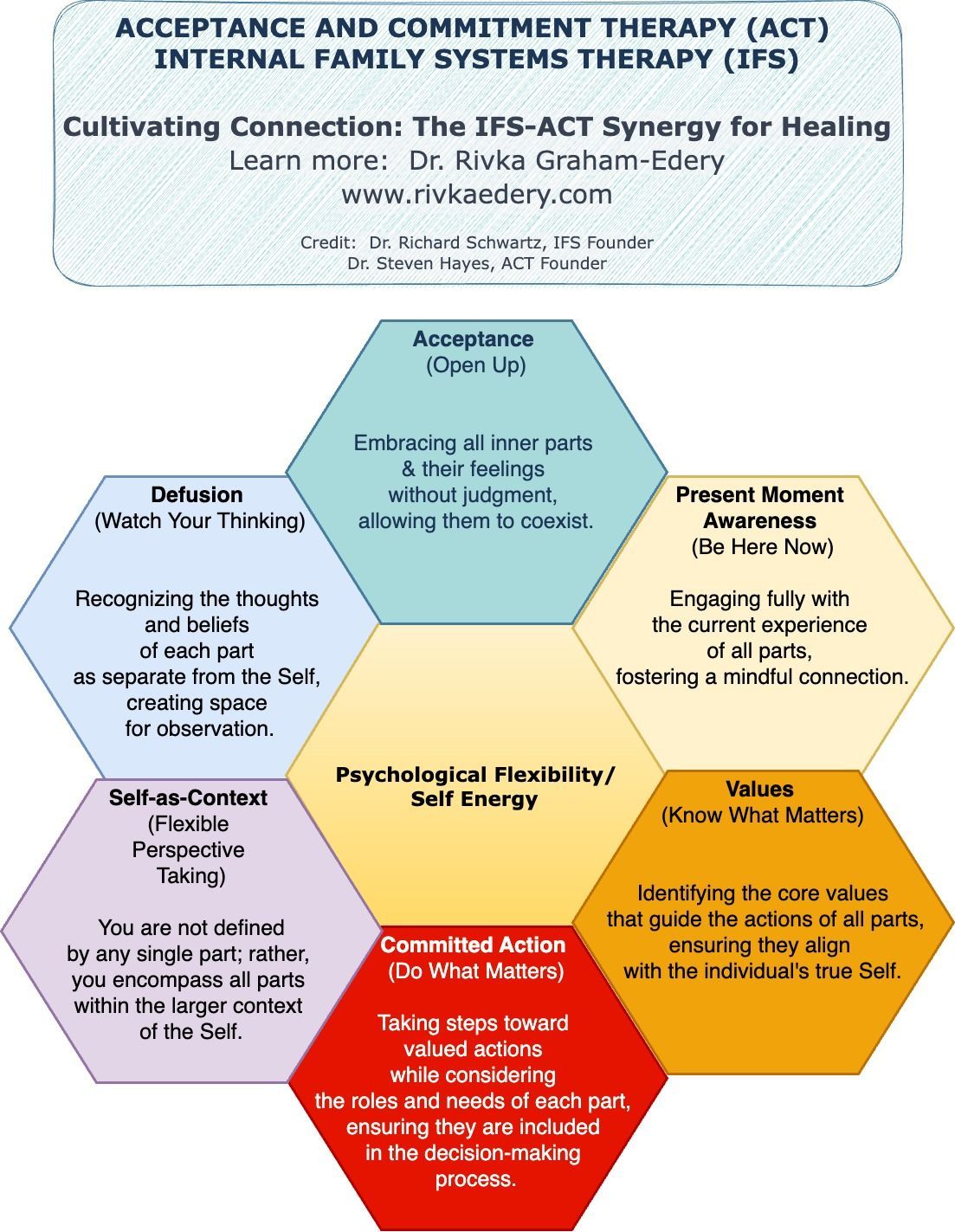
Cultivating Connection: The IFS-ACT Synergy for Healing
By: Dr. Rivka Graham-Edery.
www.rivkaedery.com
Credit: Dr. Richard Schwartz, IFS Founder
Dr. Steven Hayes, ACT Founder
These steps outline a therapeutic framework for integrating Internal Family Systems (IFS) and Acceptance and Commitment Therapy (ACT). It's a roadmap for therapists to help clients achieve deep healing and cultivate connection.
Think of it as a cyclical process with six key stages:
Mapping the inner world: Understanding the client's "internal family" of different parts and how they interact with each other and ACT processes.
Analyzing patterns: Identifying how these parts and processes contribute to unhelpful patterns and psychological inflexibility.
Developing strategies: Creating a plan to address these patterns, respecting the protective function of parts while promoting change.
Implementing techniques: Using IFS and ACT methods to foster self-compassion, mindfulness, and values-guided action.
Tracking progress: Measuring how the client is doing and adjusting the approach as needed.
Adapting flexibly: Revisiting any of the previous steps to ensure the therapy remains responsive to the client's evolving needs.
Essentially, it's a dynamic and collaborative approach to therapy that honors the complexity of the client's inner world while providing a structured path towards healing and growth.
Combining Acceptance and Commitment Therapy (ACT) with Internal Family Systems (IFS) is a powerful approach to fostering deep healing. Here’s how and why this integrative process is essential:
1. Preliminary Network: Mapping Connections
Why It’s Important: Mapping out the internal relationships among the client's parts (IFS) and the core processes of ACT (such as acceptance, defusion, and values clarification) allows for a comprehensive understanding of the client's inner world. This step highlights the interplay between different parts and processes, setting the stage for targeted interventions.
2. Functional Analysis: Decoding Patterns
Why It’s Important: Transforming the preliminary network into a process-based understanding helps identify how maladaptive patterns have developed and persisted. Examining the client’s thoughts and feelings (linked to their parts) reveals the underlying mechanisms of psychological inflexibility, which is crucial for effective treatment planning.
3. Treatment Planning: Crafting Strategies
Why It’s Important: Developing strategies to disrupt the internal network's dominant features addresses the protective and harmful aspects of the client's parts. Engaging with protectors (IFS) while employing ACT techniques like acceptance and defusion creates a balanced approach that respects the client’s defenses while promoting change.
4. Intervention: Implementing Techniques
Why It’s Important: Using methods aligning with ACT and IFS principles ensures that interventions are holistic and cohesive. This integration allows for exercises that foster self-compassion, mindfulness, and values-guided actions, which are critical for addressing the concerns of the client’s parts and promoting overall well-being.
5. Measurement: Tracking Progress
Why It’s Important: Consistently assessing key change processes, the quality of the therapeutic relationship, and the client’s progress toward their values-based goals provides valuable feedback. This evaluation helps therapists adjust interventions as needed, ensuring that therapy remains effective and aligned with the client’s evolving needs.
6. Recycling: Adapting Flexibly
Why It’s Important: Revisiting any of these steps as needed allows for a flexible and responsive approach to therapy. This adaptability honors the client’s internal system and journey toward psychological flexibility, making the therapeutic process more dynamic and client-centered.
By embracing this integrative framework, therapists can effectively combine the strengths of ACT and IFS to support clients in their healing journeys, fostering deeper connection and sustained growth.
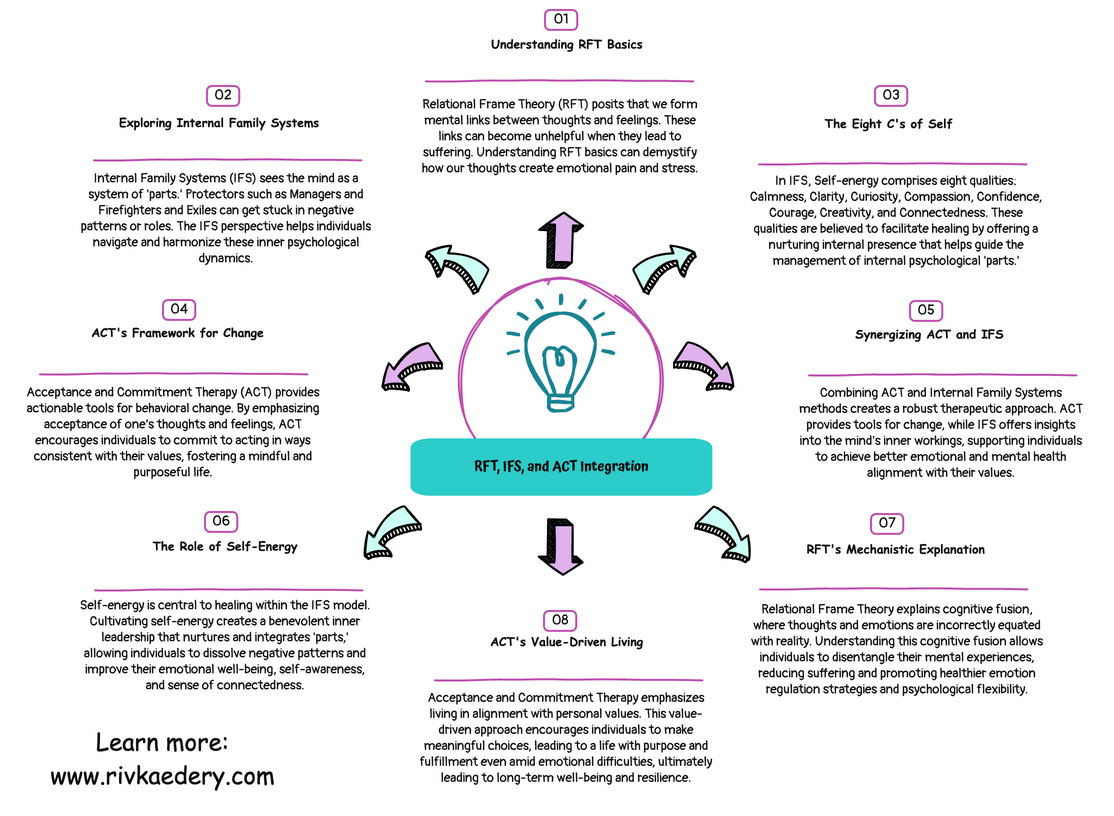
Beyond Band-Aids: Heal the Roots of Your Suffering with This Powerful Trio
Tired of just managing your symptoms? It's time to go deeper. Relational Frame Theory (RFT), Internal Family Systems (IFS), and Acceptance and Commitment Therapy (ACT) offer a powerful combination to heal the underlying causes of your suffering.
RFT explains how our minds create unhelpful links between thoughts and feelings, leading to anxiety, depression, and other struggles.
IFS views our inner world as a collection of "parts," like the "Worried Protector" or the "Inner Critic," that can get stuck in unhelpful patterns.
ACT provides practical tools to untangle those patterns, accept your inner "parts," and live a life aligned with your values.
But here's the real magic: IFS helps you tap into your "Self-energy" – your inner source of Calmness, Clarity, Curiosity, Compassion, Confidence, Courage, Creativity, and Connectedness – to heal and transform.
This integrated approach offers a powerful synergy:
RFT: Illuminates the "why" behind your struggles.
IFS: Provides a compassionate framework for understanding your inner world.
ACT: Gives you the tools to break free and create lasting change.
Ready to move beyond band-aid solutions and experience true healing?
Learn more on RFT, ACT & IFS:
RFT Books:
1). Learning RFT: An Introduction to Relational Frame Theory and its Clinical Applications by Niklas Törneke
2). Relational Frame Theory: A Post-Skinnerian Account of Human Language and Cognition by Steven C. Hayes, Dermot Barnes-Holmes, and Bryan Roche
Online Resources:
Association for Contextual Behavioral Science (ACBS): Their website (contextualscience.org) has articles, videos, and other resources on RFT.
FoxyLearning: Offers an interactive online course on RFT (foxylearning.com)
Acceptance and Commitment Therapy (ACT):
ACT Books:
1) Acceptance and Commitment Therapy: The Process and Practice of Mindful Change by Steven C. Hayes, Kirk D. Strosahl, and Kelly G. Wilson
2). ACT Made Simple: An Easy-to-Read Primer on Acceptance and Commitment Therapy by Russ Harris
3). The Happiness Trap: How to Stop Struggling and Start Living by Russ Harris (a more accessible introduction to ACT concepts)
Websites:
Association for Contextual Behavioral Science (ACBS): (contextualscience.org)
Internal Family Systems (IFS):
IFS Books:
1). Internal Family Systems Therapy (2nd Edition) by Richard C. Schwartz
2). No Bad Parts: Healing Trauma and Restoring Wholeness with the Internal Family Systems Model by Richard C. Schwartz
Websites and Organizations:
The Center for Self Leadership: (selfleadership.org) - Offers IFS trainings, workshops, and resources.
IFS Institute: (ifs-institute.com) - Provides information about IFS, therapist directories, and online resources.
Looking to join our community? Sign up here:
Beyond Acceptance: Your Inner Parts Welcome to an ACT & IFS Community Facebook Group
https://www.facebook.com/share/utKN6WT4Bgp6gAtW/
Host, IFS Community Zoom Gatherings
https://us06web.zoom.us/meeting/register/tZcsdOyrrjMsGNGaz59sSFkoWXK1bB2ktHKM
Contact me here:
Dr. Rivka A. Graham-Edery, Psy.D., M.S.W., L.C.S.W., CCTP-II, CAIMHP, CSTS, M-RAS
Email: redery@rivkaedery.com
Website: www.rivkaedery.com
Level III Certification in Somatic Parts.
Level II Trauma Certification.
Informed by ACT, IFS, ACA, and PVT practices.
ACBS Board Member at Large
#RFT #IFS #ACT #MentalHealth #Therapy #Wellbeing #InnerPeace #SelfCompassion
Like a gentle guide, IFS therapy leads you to the radiant wisdom of your core Self, where you can access boundless Self-energy, express gratitude to your Protectors (Managers & Firefighters), and finally, welcome home your exiled parts with profound love and understanding.
Learn more: https://ifs-institute.com/
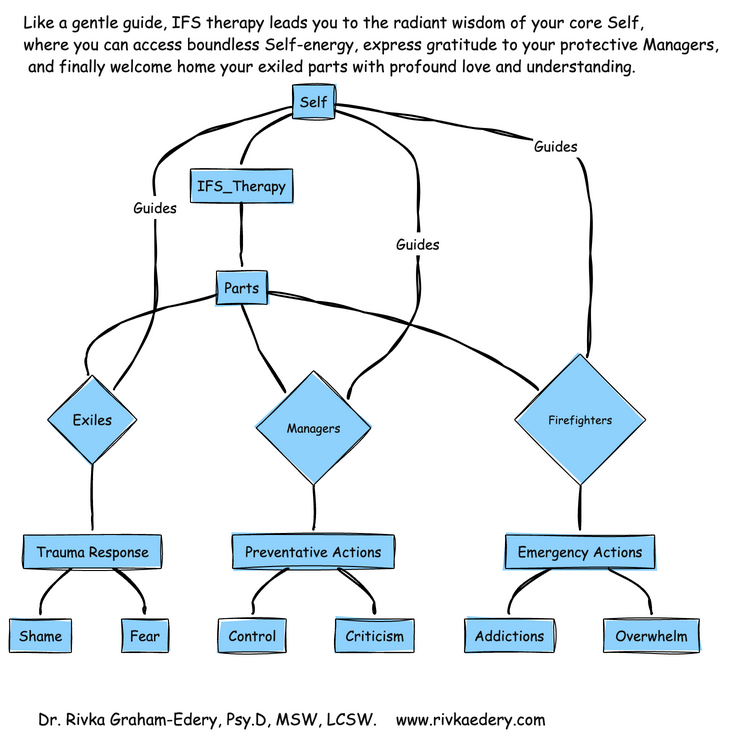
THERAPISTS: Ready to Level Up Your Therapy Game? Grab These Free IFS & ACT Goodies!
Are you looking to enhance your practice and empower clients on their healing journey? Download these FREE resources designed to support therapists integrating Internal Family Systems (IFS) and Acceptance and Commitment Therapy (ACT):
1) Comprehensive Intake Form: This detailed intake form streamlines your assessment process, gathering crucial information about your client's history, challenges, and therapeutic goals.
2) Real-Life Session Notes: These in-depth session notes offer valuable insights into the practical application of IFS and ACT and showcase the therapist's reflections and considerations throughout the therapeutic process.
3) Structured Treatment Plan: Implement a clear and effective treatment approach with this integrated plan, outlining phases, goals, and interventions for clients navigating complex trauma and abandonment issues.
These resources are particularly valuable for therapists working with foster care youth and individuals struggling with abandonment wounds. They can be tailored for any client.
Download these free tools today and unlock new possibilities for healing and transformation in your practice!
https://drive.google.com/drive/folders/1EjtwPEkGbbbNAjUww2C7kVXt6m-hJSku?usp=sharing
Please note: These documents are intended as samples and resources for mental health professionals and should not be used as a substitute for professional advice or treatment.
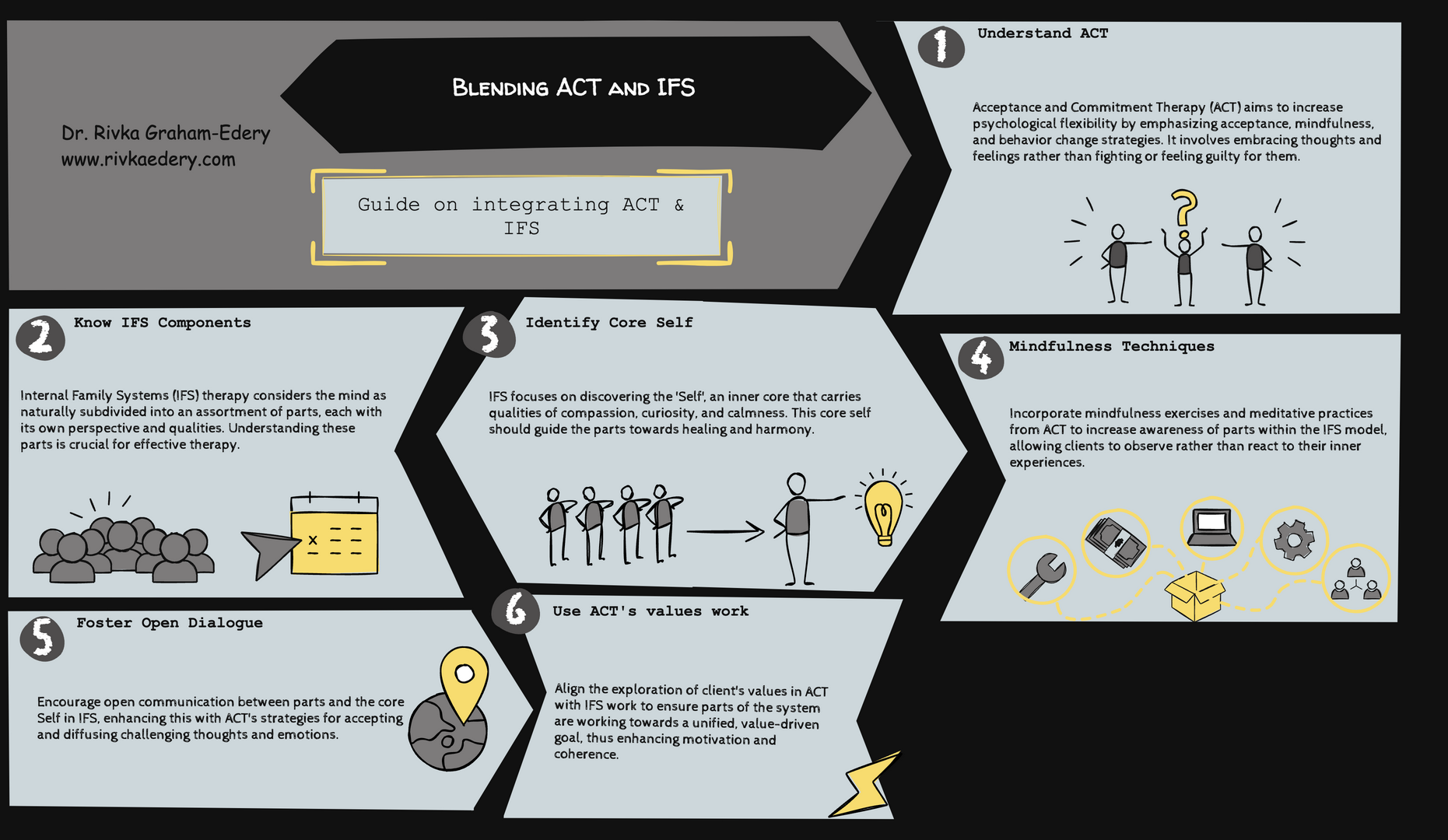
From Thoughts to Self: A Therapist's Guide to Blending ACT & IFS
Dr. Rivka Edery, PsyD, L.C.S.W
September 10, 2024
A core part of my work as a therapist, blending ACT & IFS, is this statement, "I am not my thoughts but the one having them." This resonates well with both IFS and ACT.
In IFS:
1) It reinforces the idea of the Self as distinct from parts.
2) Reminds us that we can observe and relate to our parts rather than being fused with them.
3) Can be used during unblending exercises to create space between Self and a part.
In ACT:
1) Aligns with the concept of defusion - separating ourselves from our thoughts and observing them without getting entangled.
2) It can be a helpful reminder during mindfulness practices to observe thoughts passing by without judgment.
3) Encourages a sense of agency and choice in responding to our thoughts.
Integrating into Therapy:
4) Use it as a mantra or affirmation to reinforce the core principle of both therapies.
5) Introduce it early in therapy to set the stage for further exploration of parts or defusion work.
6) Refer to it when clients get caught up in thoughts or emotions. Example: "Remember, you are not your anxiety (fill in the blank), but the one experiencing it. Let's step back and observe it with curiosity."
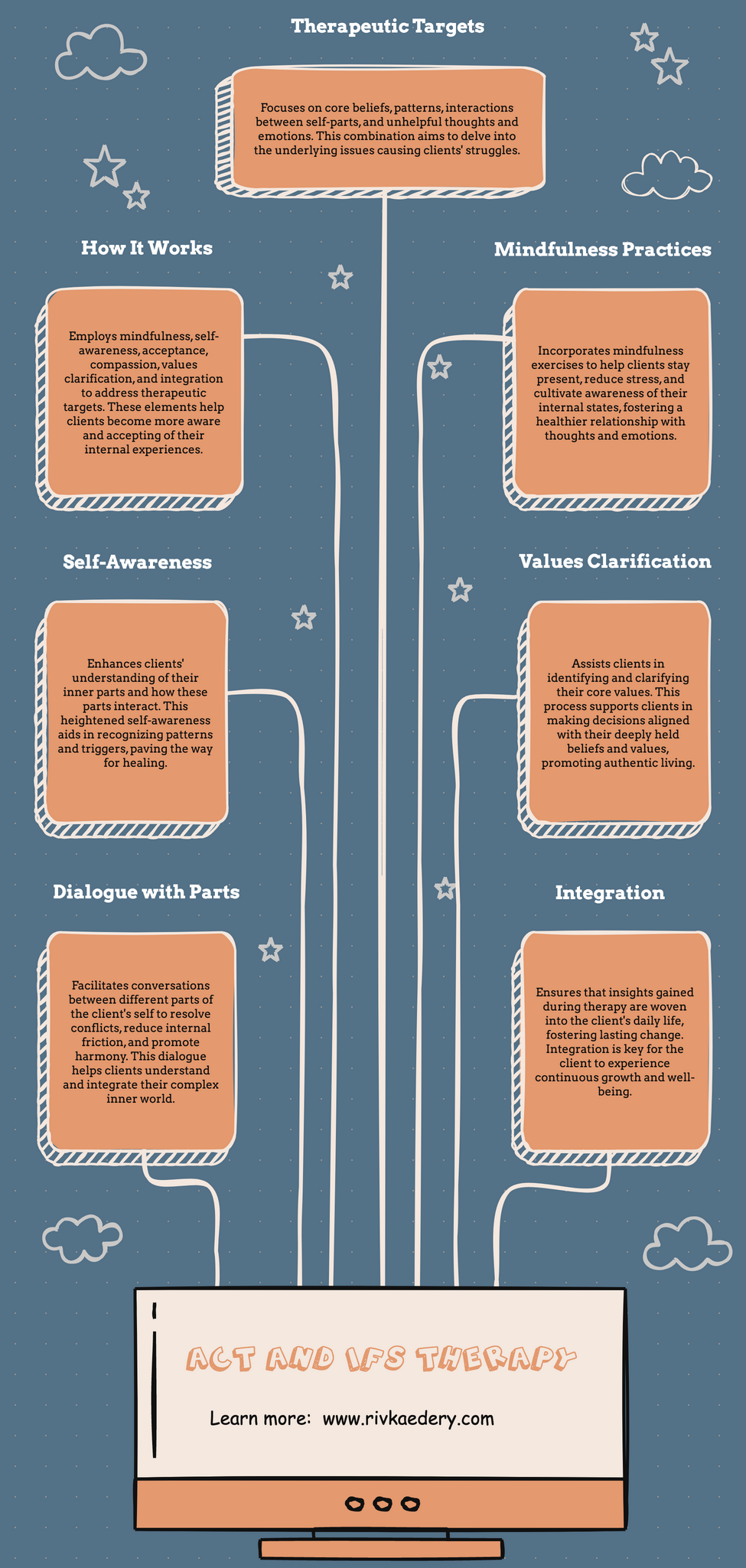
Rewiring Minds: An ACT-IFS Approach to Transform Core Beliefs
Dr. Rivka Edery, Psy.D, MSW, LCSW
www.rivkaedery.com
Free to use and share.
July 20, 2024
Are you a therapist seeking more than just surface-level solutions? Discover the awe-inspiring, transformative power of ACT (Acceptance and Commitment Therapy) and IFS (Internal Family Systems) to address the root causes of your client’s struggles, break through barriers, and facilitate profound change.
This infographic showcases a unique therapeutic approach that synergizes Acceptance and Commitment Therapy (ACT) and Internal Family Systems (IFS). This powerful combination equips therapists to delve into the root causes of their clients' struggles.
Here are the main highlights:
Therapeutic Targets:
- Central Beliefs and Patterns: Identify and address core beliefs (e.g., “I’m not good enough”) and patterns (e.g., avoidance) that fuel unhelpful emotions and behaviors.
- Interplay Between Parts: Delve into the connections and interactions between different parts of the self (e.g., a critical and vulnerable part), fostering understanding and cooperation.
- Unhelpful Thoughts and Emotions: Equip clients with the skills to observe and accept complex thoughts and emotions without becoming overwhelmed, thereby reducing their impact.
How It Works:
- Mindfulness & Self-Awareness: Utilize ACT’s mindfulness techniques and IFS’s focus on connecting with the core Self to cultivate present-moment awareness and a deeper understanding of internal experiences.
- Acceptance & Compassion: Both approaches emphasize accepting emotions and parts without judgment, reducing internal conflict and paving the way for healing.
- Values & Integration: ACT’s values clarification process aligns individuals’ actions with their core values, while IFS guides them towards integrating different parts to achieve internal harmony.
- Psychological Flexibility: Individuals enhance their adaptability and resilience by learning to observe thoughts and emotions (ACT) and compassionately understand different parts (IFS).
Practical Applications for Therapists:
- Assessment: Use IFS to map out a client’s internal system, identifying key parts and their roles. Then, employ ACT to assess how these parts interact with thoughts and emotions.
- Mindfulness Practices: Teach clients ACT mindfulness techniques to observe their thoughts and emotions without getting entangled. This promotes acceptance and creates distance from difficult emotions.
- Dialogue with Parts: Use IFS techniques to facilitate communication between different parts of the self. Assist clients in understanding the needs and motivations of each part, fostering compassion and cooperation.
- Values Clarification: Implement ACT exercises to help clients identify their core values. Please encourage them to make choices aligned with these values, even when facing challenging emotions.
- Integration: Guide clients towards integrating different parts of themselves by finding common ground and shared goals. This can lead to greater internal harmony and a sense of wholeness.
By integrating ACT and IFS into their practice, therapists can offer a comprehensive approach that addresses the root causes of a client’s struggles, fostering lasting change and a more profound sense of well-being.
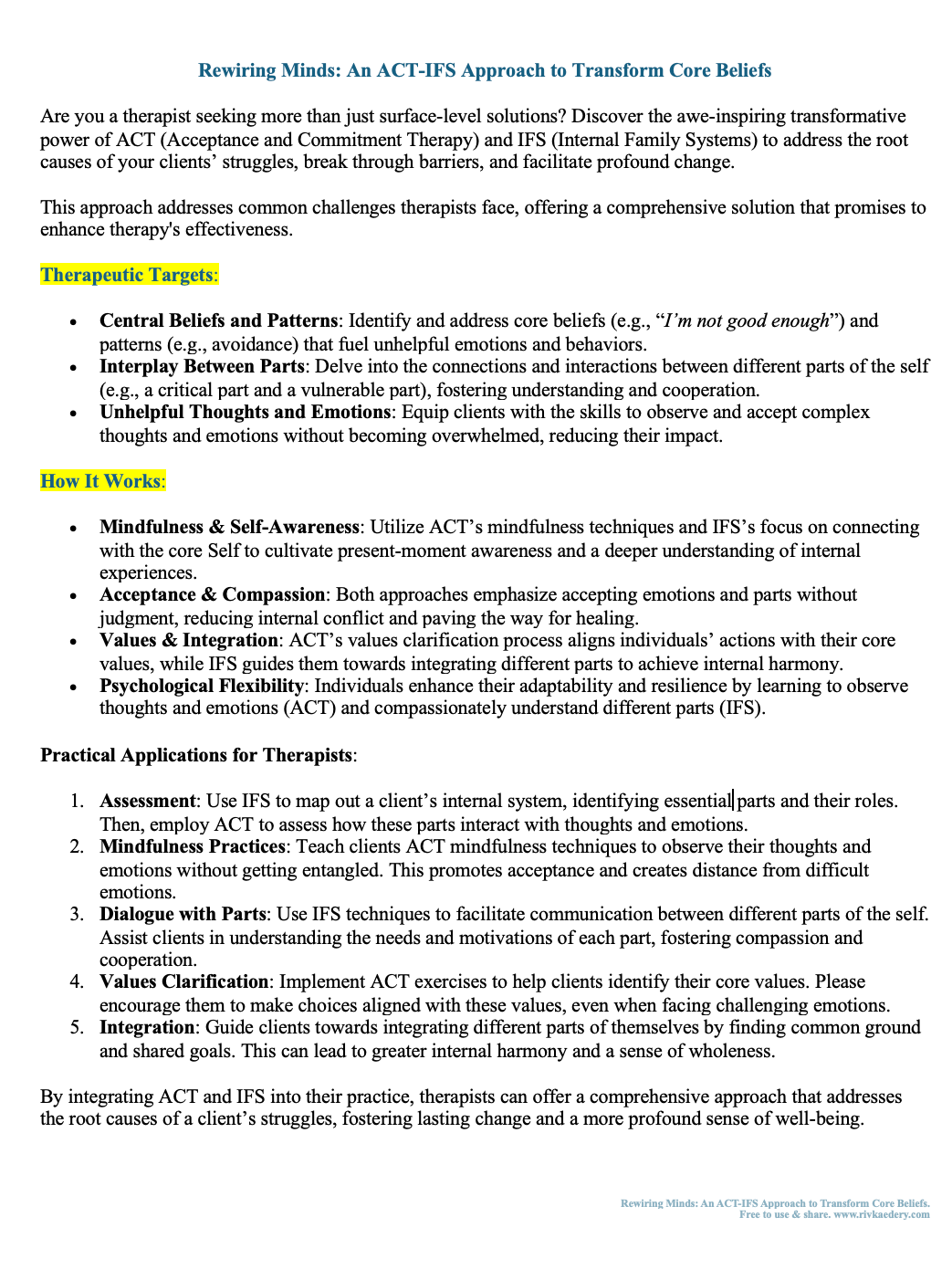
Your Path to Healing: Personalized IFS & ACT Therapy (Insurance-Eligible)
This comprehensive treatment plan outlines a personalized, insurance-eligible therapeutic approach integrating
Internal Family Systems (IFS) and
Acceptance and Commitment Therapy (ACT) to facilitate healing and well-being. By fostering self-compassion, enhancing emotional awareness, and cultivating psychological flexibility, clients embark on a transformative journey towards healing and wholeness. This integrative approach, utilizing diagnostic codes and treatment modalities recognized by insurance providers, guides clients through
identifying and healing inner parts, clarifying values, and taking committed action towards a life aligned with their authentic self. Clients are empowered to navigate challenges with resilience, build healthier relationships, and create lasting positive change, all while benefiting from potential insurance reimbursement.
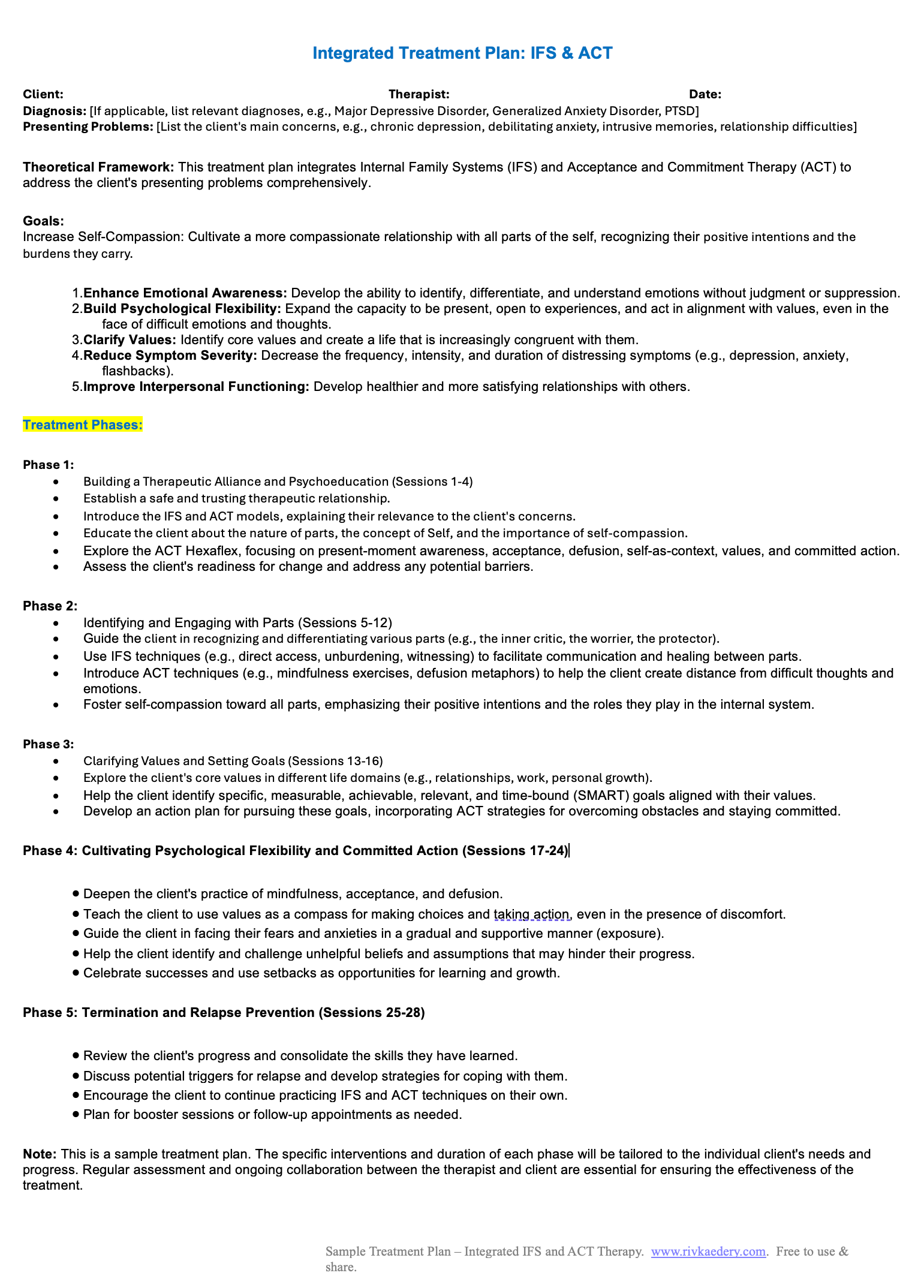
SAMPLE IFS - ACT INTAKE FORM
July 7th, 2024
The benefit for therapists in using a tailored treatment plan that integrates IFS and ACT, is the consideration of people's parts, Self-Energy, psychological flexibility, and their values. It empowers individuals to take control of their lives and commit to transformative actions, instead of just focusing on symptom elimination. This integrative approach of combining IFS and ACT, offers a strategy for those seeking enduring change. It presents an practical route to healing, self improvement and leading a life that resonates with ones' core values, and Self-Energy. A potent partnership, when given the chance.
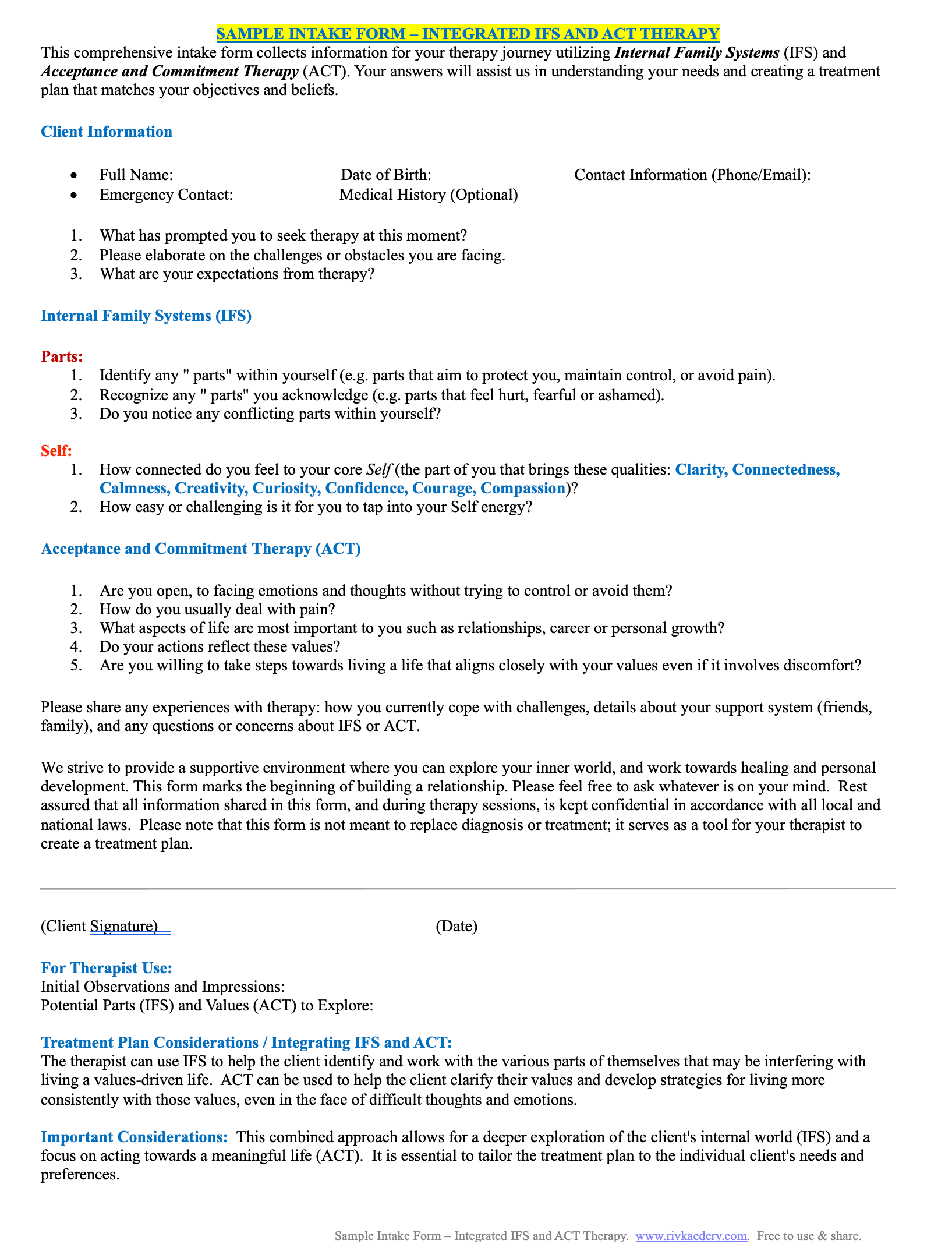

Little Mirrors: How Our Children Reflect Our Inner Parts
Unlock the Transformative Power of Internal Family Systems (IFS) in Parenting
Discover a Hopeful and Inspiring Path to More Empathetic and Effective Parenting
July 3, 2024
Are you ready to transform your parenting journey? Delve into the depths of Internal Family Systems (IFS) and uncover how your child can become a mirror reflecting your inner world.
In this short and compelling article, author and passionate IFS advocate Dr. Rivka Edery shares a personal anecdote about the transformative power of recognizing and embracing one's inner child, leading to a deeper connection with one's children.
Through the lens of IFS, you will:
Understand the concept of "parts": Learn how your inner child, protector, critic, and other parts influence your interactions with your child.
Embrace the power of Self: Discover how operating from your essence – characterized by Calmness, Curiosity, Clarity, Compassion, Confidence, Courage, Creativity, and Connectedness – can create a secure base for your child.
Recognize to heal your "exiled" parts: Identify and address the unseen and unheard parts of yourself, fostering compassionate patience and understanding in your parenting.
Cultivate awareness of your internal landscape: Gain insights into how your child's behaviors may mirror your unresolved issues.
Join us on this journey to create a more harmonious and nurturing environment for your child to thrive.
You can read the full article now and unlock the transformative potential of IFS in your parenting journey.
https://partsandself.org/little-mirrors/
Exploring Defusion in IFS:
The Angry Protector.
June 26th 2024
Key Concept: Defusion is about creating distance between our thoughts and emotions, understanding that they’re not who we are. This lessens their impact on us. Application in IFS: Within the IFS framework, we see our parts (like protectors) as distinct entities with their viewpoints and roles. Defusion allows us to step back from the protectors’ anger grasp without getting overwhelmed and develop a connection with that part.
Practical Exercises for Dealing with Angry Protectors
- Acknowledging the Anger: Recognize & label the anger within the protector. For instance, say something like, “Hello, Angry Protector. I notice you’re experiencing anger at this moment.” This is the opposite of avoidance & all its attending struggles.
- Externalizing the Anger: Encourage the protector to visualize their anger as separate from themselves. It could be depicted as a cloud, a flame, or any fitting visual representation.
- Recognizing the Emotion: Encourage the protector to pay attention to the feeling of anger, how it affects the body, the thoughts it brings up, and how it changes in intensity.
- Explaining the Anger: Prompt the protector to explain the anger in detail using words that describe its characteristics and features. “I feel a strong pulsating sensation in my chest.”
- Appreciating the Anger: Show gratitude towards the protector for trying to keep you safe, even though its methods may seem extreme. “Thank you, Angry Protector, for looking out for me. I know you’re doing your best.”
- Creating Space: Remind the protector that anger is an emotion, a passing experience. “You are not defined by your anger. This feeling will fade away.”
Communication Skills for The Angry Protector
Use Personal Statements: When talking to the protector, use statements starting with “I” to build connection and empathy. My favorite: “I see you.”
Practice Mindfulness: Mindfulness activities can help you and your protector stay present and reduce impulsiveness.
Consider Seeking Professional Support: If you’re new to IFS or find it challenging to deal with your parts, consider talking to a therapist who is trained in IFS.
Sample Conversation
- *You;** (speaking to the Angry Protector) I sense that you’re really upset now. Can you share more about what's causing this anger?
- **Angry Protector;** They’re disrespecting you! I won’t stand for it!
- **You;** I hear you. Does that anger feel like a burning sensation in your chest?
- **Angry Protector** Yes, it’s like a fire!
- **You;** Thank you for looking out for me. I value that. Just remember, you are not defined by this anger. It’s an emotion. It will fade away.
Main Advantages of applying the IFS/ACT approach
- Less Reactivity: Defusing helps you and the protector handle anger calmly and thoughtfully.
- Enhanced Self-Compassion: You nurture an internal system by recognizing the protector's intentions.
- Empowerment: Defusing equips you with strategies to cope with emotions and develop self-leadership skills.
Feel free to ask for examples or advice on tailoring these workouts to your unique circumstances!
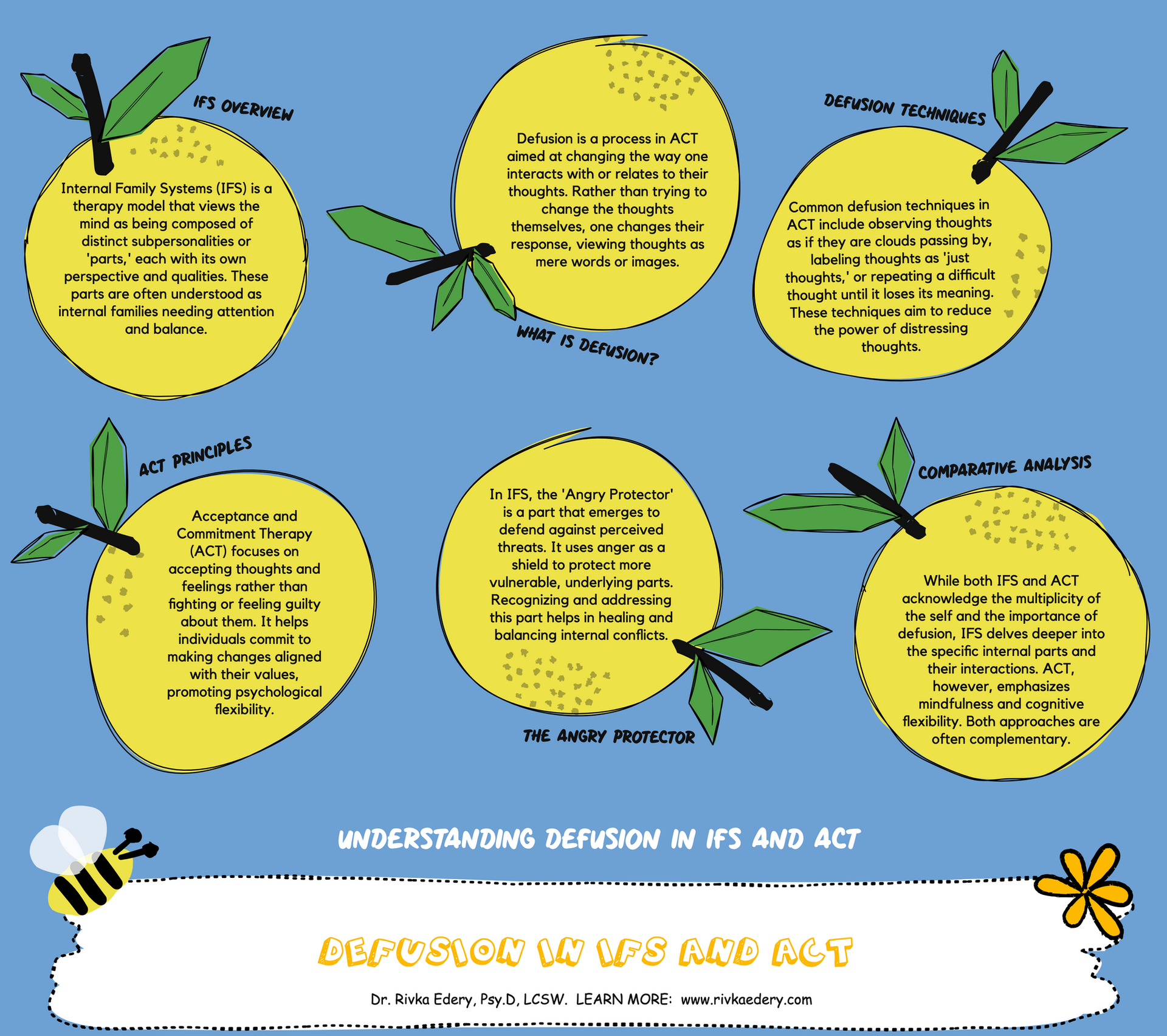
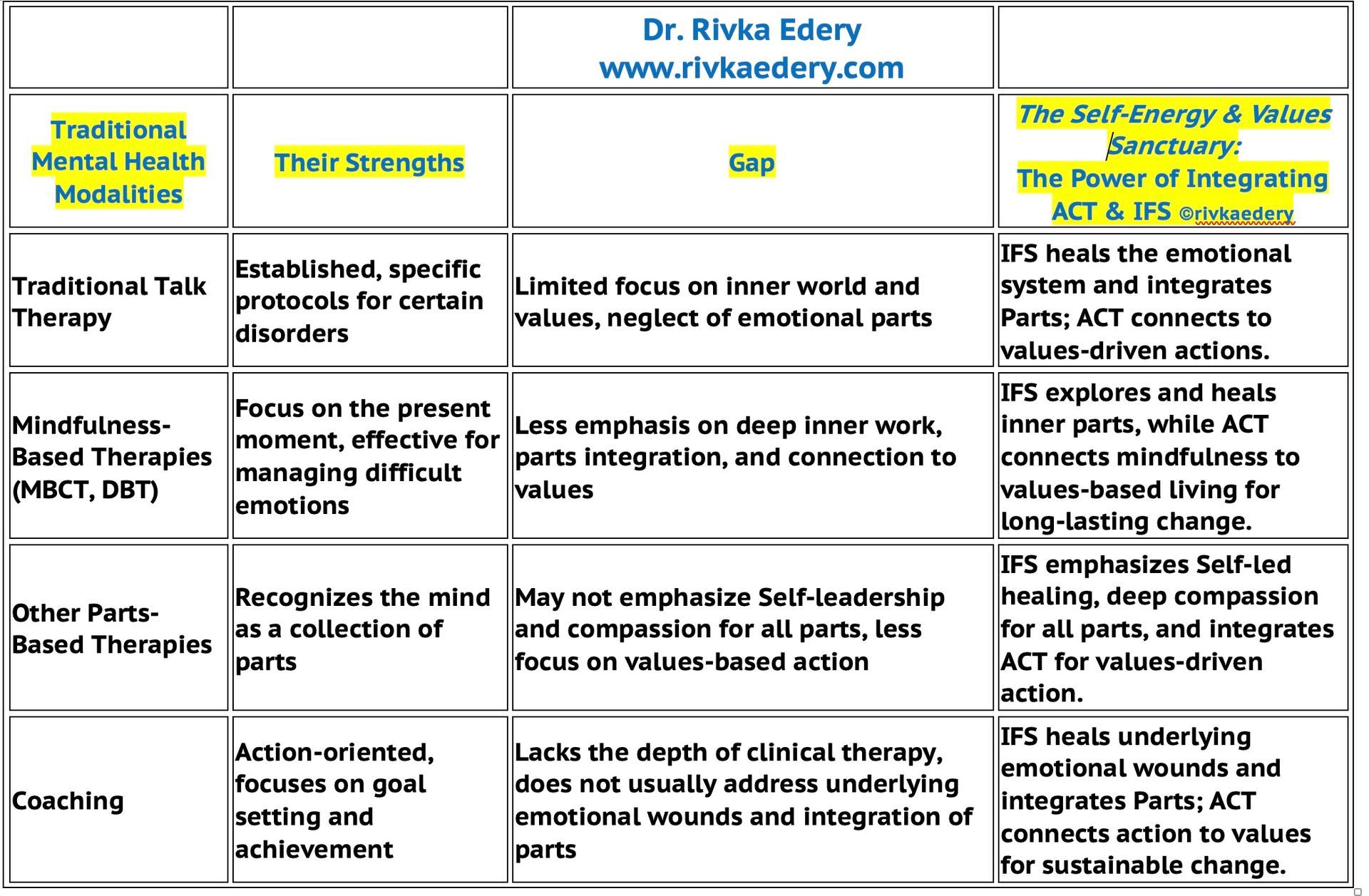
The Self-Energy & Values Sanctuary
Heal Your Parts,
Unleash Your Values Through Action.
Dr. Rivka Edery, Psy.D, MSW, LCSW
www.rivkaedery.com
*Why I started the "Beyond Acceptance: Your Inner Parts Welcome to an ACT & IFS Community Facebook Group"*
As therapists, we know the power of deep healing. Yet, traditional approaches often need to catch up. I'm excited to share the transformative combination of Internal Family Systems (IFS) and Acceptance and Commitment Therapy (ACT) with you. These modalities revolutionized my life and practice. The impact was so profound that I wish I had discovered them sooner!
Introducing the "Beyond Acceptance" Facebook Group
https://www.facebook.com/share/utKN6WT4Bgp6gAtW/
This is a safe, private space for therapists like you who are curious about or experienced with IFS and ACT. Let's:
· Learn Together: Share resources, insights, and case studies.
· Support Each Other: Discuss challenges and celebrate successes in our work.
· Grow Professionally: Deepen our understanding and integration of IFS & ACT.
Why IFS & ACT?
This unique pairing allows us to:
· Heal Deep Emotional Wounds: Go beyond symptom management and address the root cause of suffering.
· Empower Clients: Help them connect with their innate wisdom and compassion (Self-energy).
· Cultivate Values-Driven Action: Guide clients toward living a life that aligns with their values.
I've attached a chart showing how this approach fills the gaps left by other modalities.

Rewrite Your Inner Story, Free Your Future: A Journey with IFS & ACT
Ever feel like you're living out a story you didn't write? Are there hidden parts of you whispering tales of pain, longing, or even wisdom you've yet to hear?
Your inner world is a rich tapestry of experiences, beliefs, and emotions—a cast of characters with unique voices and perspectives. Internal Family Systems (IFS) invites you to meet these "parts" with curiosity and compassion and understand their roles in your life's narrative.
Acceptance and Commitment Therapy (ACT) empowers you to rewrite that story. It equips you with tools to navigate your inner landscape, embracing difficult emotions and choosing actions aligned with your values.
Together, IFS and ACT offer a transformative journey:
• Uncover Hidden Narratives: Give voice to your inner parts and understand their influence.
• Reshape Your Inner Landscape: Heal old wounds and create a more harmonious relationship with yourself.
• Live a Values-Driven Life: Free yourself from limiting beliefs and create a future that reflects your authentic self.
Questions for Inner Exploration:
1. If your inner parts could speak freely, what untold stories or hidden wisdom might they share?
2. Imagine your life as a landscape: What parts of the terrain represent the influence of your inner parts, and how can IFS & ACT help you reshape that landscape?
3. If you could send a message of compassion and understanding to the most vulnerable part of yourself, what would you say?
Let's embark on this journey together! Share your reflections and experiences in the comments below. Let's create a space for healing, growth, and rewriting our stories.
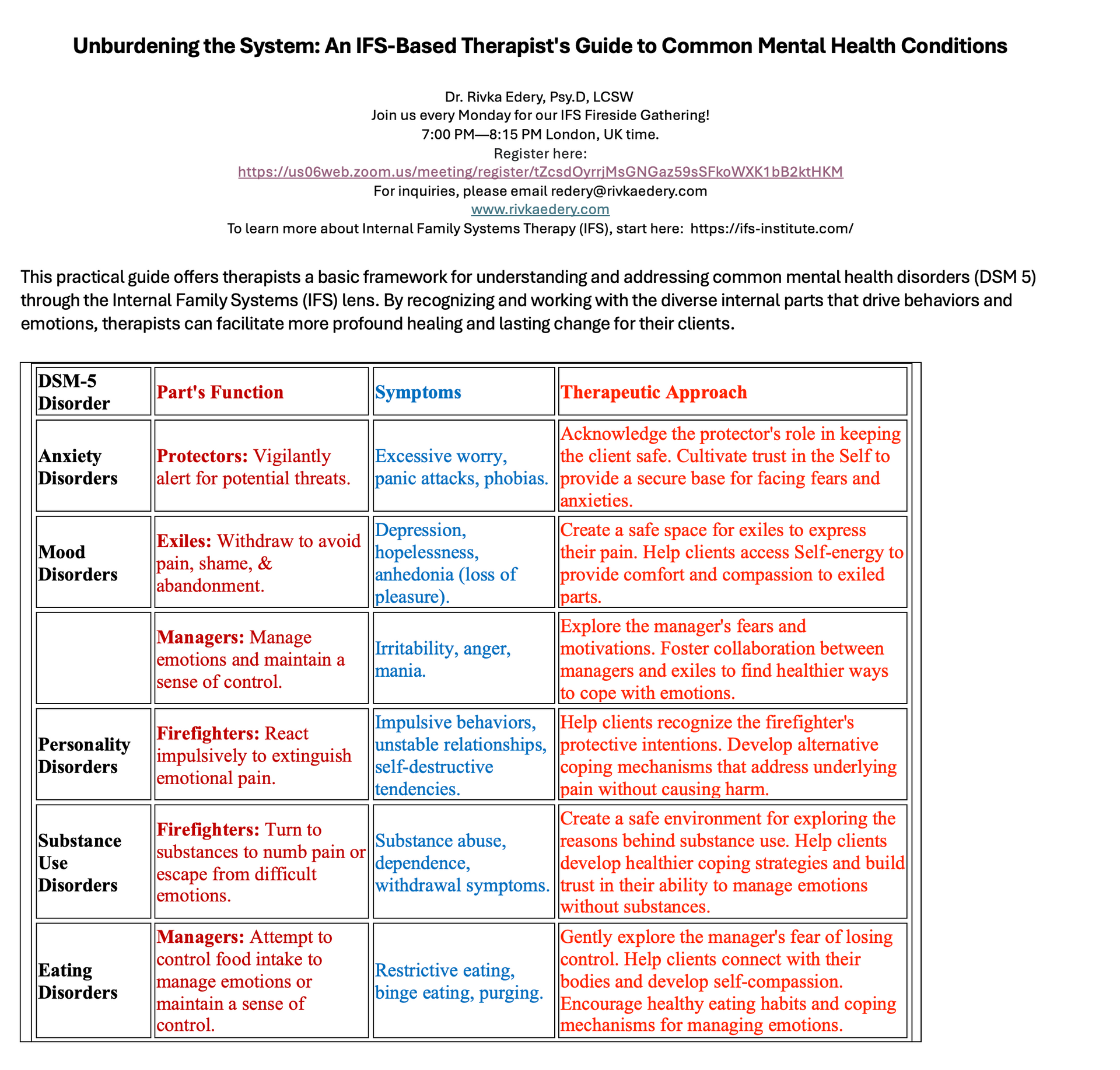
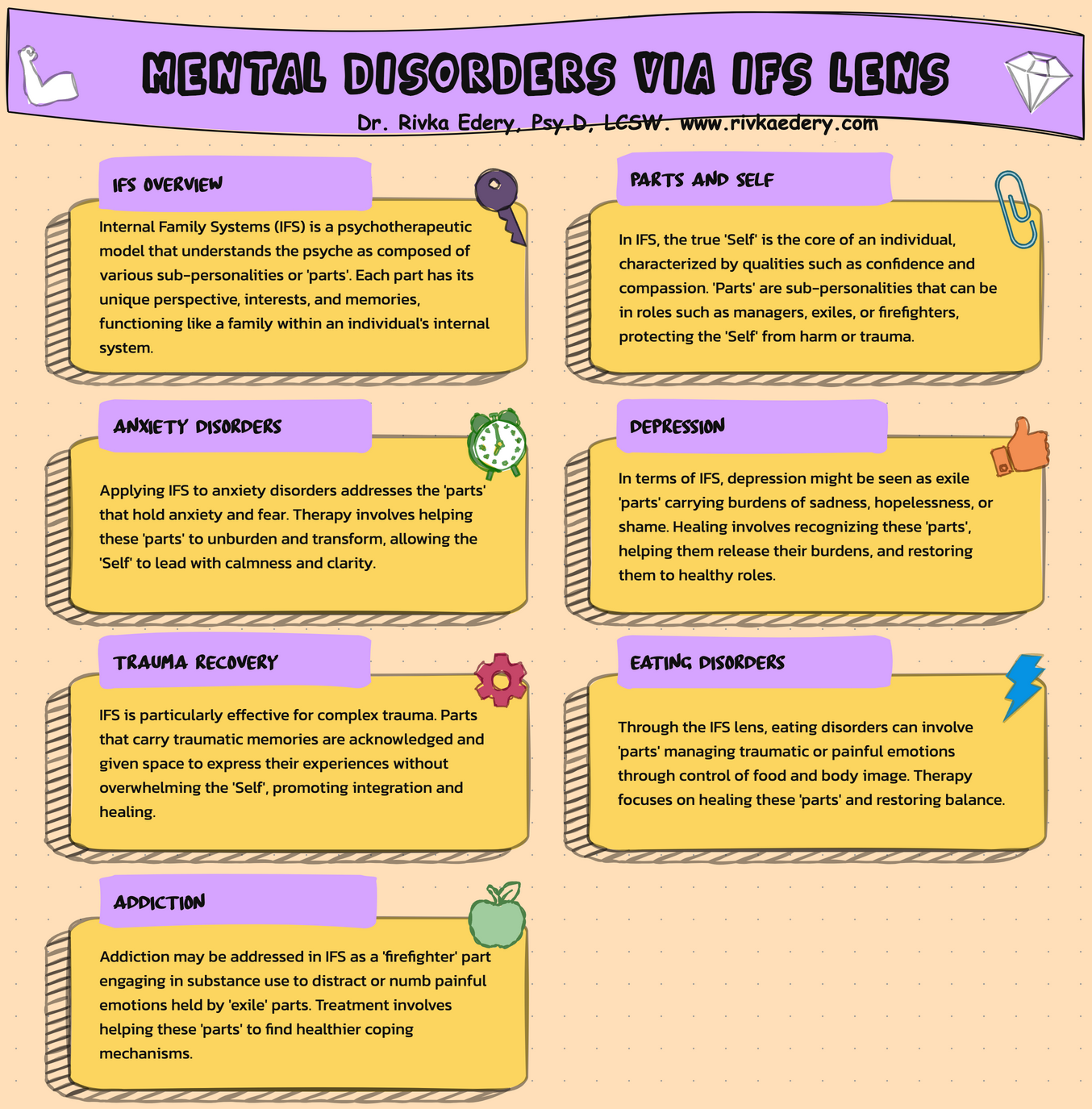
Unburdening the System: An IFS-Based Therapist's Guide to Common Mental Health Conditions
Dr. Rivka Edery, Psy.D, LCSW
To learn more about Internal Family Systems Therapy (IFS), start here: https://ifs-institute.com/
This practical guide offers therapists a basic framework for understanding and addressing common mental health disorders (DSM 5) through the Internal Family Systems (IFS) lens. By recognizing and working with the diverse internal parts that drive behaviors and emotions, therapists can facilitate more profound healing and lasting change for their clients.
The IFS Therapeutic Process
1. Identify and Differentiate Parts: Help clients recognize the different parts within their internal system, their roles, and their intentions.
2. Understand Intentions and Polarizations: Explore the motivations behind each part's behavior, even when seemingly destructive. Uncover the underlying pain or fear driving these actions.
3. Access the Self: Guide clients to connect with their compassionate and wise Self, the core of their being that can lead to healing and integration.
4. Heal and Unburden: Validate and offer compassion to exiled parts, allowing them to release their burdens and heal from past trauma. Encourage cooperation and harmony between different parts.
Key Principles
• All Parts Are Welcome: Every part has a positive intention, even if their actions seem harmful.
• Self-Leadership: The Self is the ultimate source of healing and integration.
• Curiosity and Compassion: Approach each part with curiosity and compassion, understanding their unique roles and motivations.
By embracing the IFS model, therapists can empower clients to heal from within, creating lasting change and a more harmonious internal system.
Did you find this post helpful? If so, you can contact me with any questions or comments.
Dr. Rivka Edery, Psy.D, LCSW
Email: redery@rivkaedery.com
www.rivkaedery.com

Inner Allies: How IFS and ACT Collaborate to Shift the Inner Critic’s Narrative
By: Dr. Rivka Edery
www.rivkaedery.com
Why integrate IFS and ACT to transform the Harsh Inner Critical Manager?
This post delves into the transformative blend of Acceptance and Commitment Therapy (ACT) and Internal Family Systems (IFS). By discussing the approach and principles of each model, we create a practical toolkit from these evidence-based models to foster a positive feedback loop in your life. This may be especially useful for those who grew up in dysfunctional, abusive, or alcoholic homes.
What’s in it for you? Eight powerful tools encourage positive mental and emotional growth, promote value-aligned decisions, and reduce avoidance, improving personal development and emotional health.
1. IFS Approach: IFS helps individuals recognize that the Inner Critic is part of a complex system of internal "parts." Each part has a positive intention for your well-being. You can transform their relationship by identifying and understanding the Inner Critic's protective role, which “Exile” it protects, and why. This begins with approaching it with curiosity and compassion rather than fear or hostility.
2. ACT Principles: ACT teaches the importance of accepting uncomfortable thoughts and feelings instead of opposing, arguing, or disagreeing. It encourages individuals to commit to actions aligned with their values, even in the presence of the Inner Critic. This process helps lessen the impact of the Critic's control by focusing on what truly matters to the individual. The goal is not to control the Critic but to accept the positive intentions and still do what will improve your life.
Apply each of the eight transformative exercises below to a current problem you are facing and note any shifts or insights that arise.
1. Self-compassion means being kind to oneself, recognizing the inner critic's role, softly challenging it, and observing it calmly.
2. Grounding decisions in values boosts self-worth and quiets the Inner Critic. This is the opposite of feeding into the harsh criticism.
3. Reduced Avoidance means confronting our parts and their experiences directly.
4. Compassion for Inner Parts: Treating our inner parts with kindness, recognizing their protective intentions.
5. Breaking the Judgment Cycle: Understanding that our critical parts aim to protect us, allowing acceptance to replace judgment.
6. Integration of Polarized Aspects: Harmonizing conflicting inner parts to achieve internal and external peace.
7. Healing Attachment Injuries: Addressing and understanding past wounds to foster secure attachment.
8. Positive Mental and Emotional Feedback Loop: Cultivating acceptance that transforms our inner world and influences our external interactions creates a powerful growth cycle.
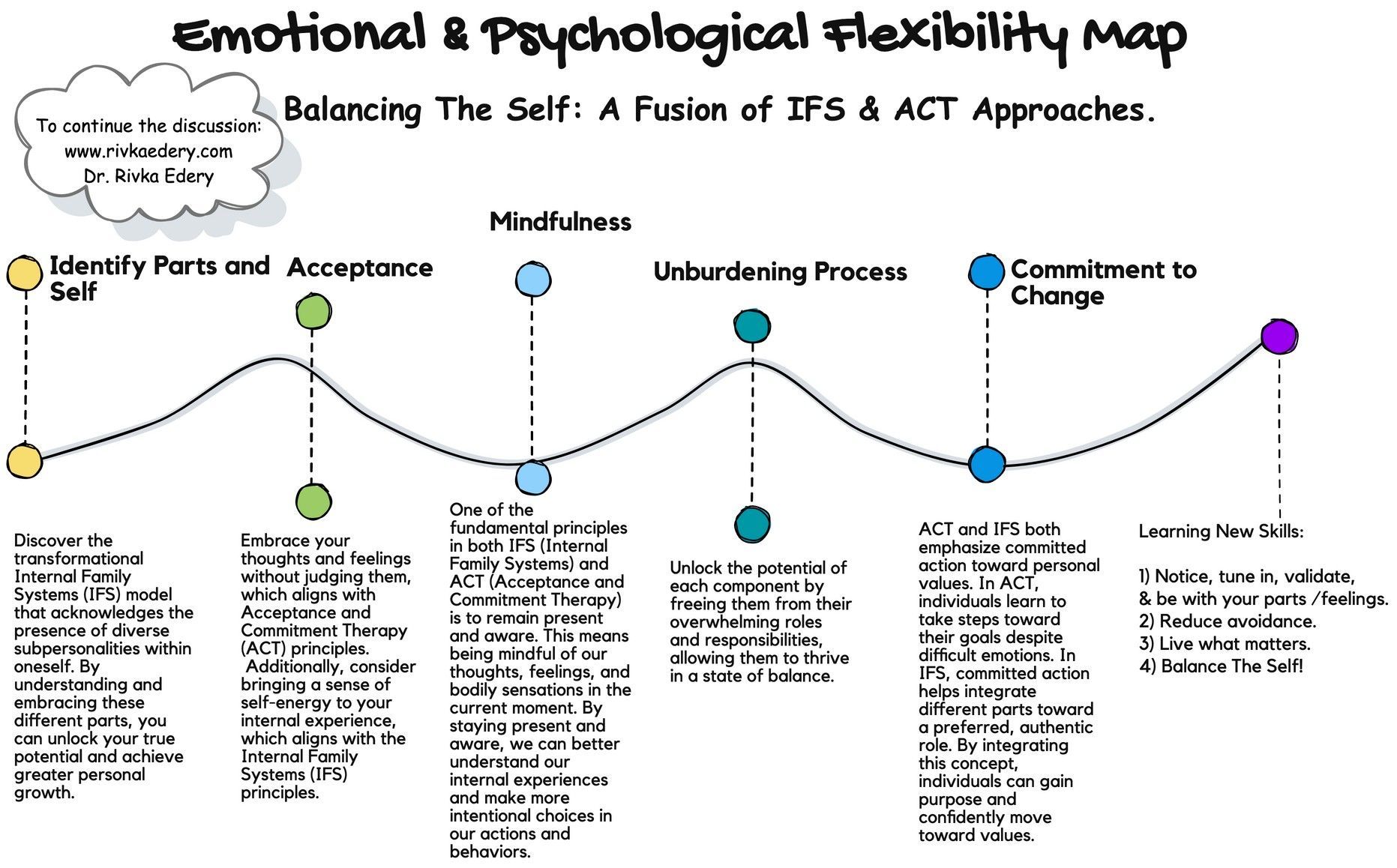
Balancing the Self: A Fusion of IFS and ACT Approaches
By: Dr. Rivka Edery
www.rivkaedery.com
The fusion of IFS and ACT provides a robust and holistic strategy, enabling individuals to master their inner worlds and cultivate emotional and psychological flexibility.
Why integrate IFS and ACT for Self-Regulation?
Combining Internal Family Systems (IFS) and Acceptance and Commitment Therapy (ACT) offers a holistic path to mental wellness, emphasizing self-compassion, acceptance, and purposeful living.
1. IFS Overview:
- Developed by Dr. Richard Schwartz, focusing on the mind's multiple subpersonalities.
- Promotes understanding and harmony among these parts, guided by a core Self characterized by curiosity, clarity, compassion, confidence, courage, creativity, connection, and calm (“the 8 C’s”).
2. Principles:
- The mind consists of various parts besides a core Self.
- No parts are inherently bad; IFS seeks to unburden them.
- The Self's qualities include compassion, clarity, and leadership.
3. Unblending Process:
- Essential for accessing the Self and engaging parts with love and care.
4. Combining IFS and ACT:
- Enhances self-awareness, emotional regulation, and alignment with personal values.
5. Applications:
- Useful for treating anxiety, depression, trauma, relationship issues, and self-esteem problems.
6. Benefits:
- Offers a comprehensive approach, empowering individuals to manage their inner worlds and build resilience.
To learn more:
Acceptance and Commitment Therapy (ACT).
https://stevenchayes.com/category/acceptance-and-commitment-therapy/
Internal Family Systems Therapy(IFS). https://ifs-institute.com/
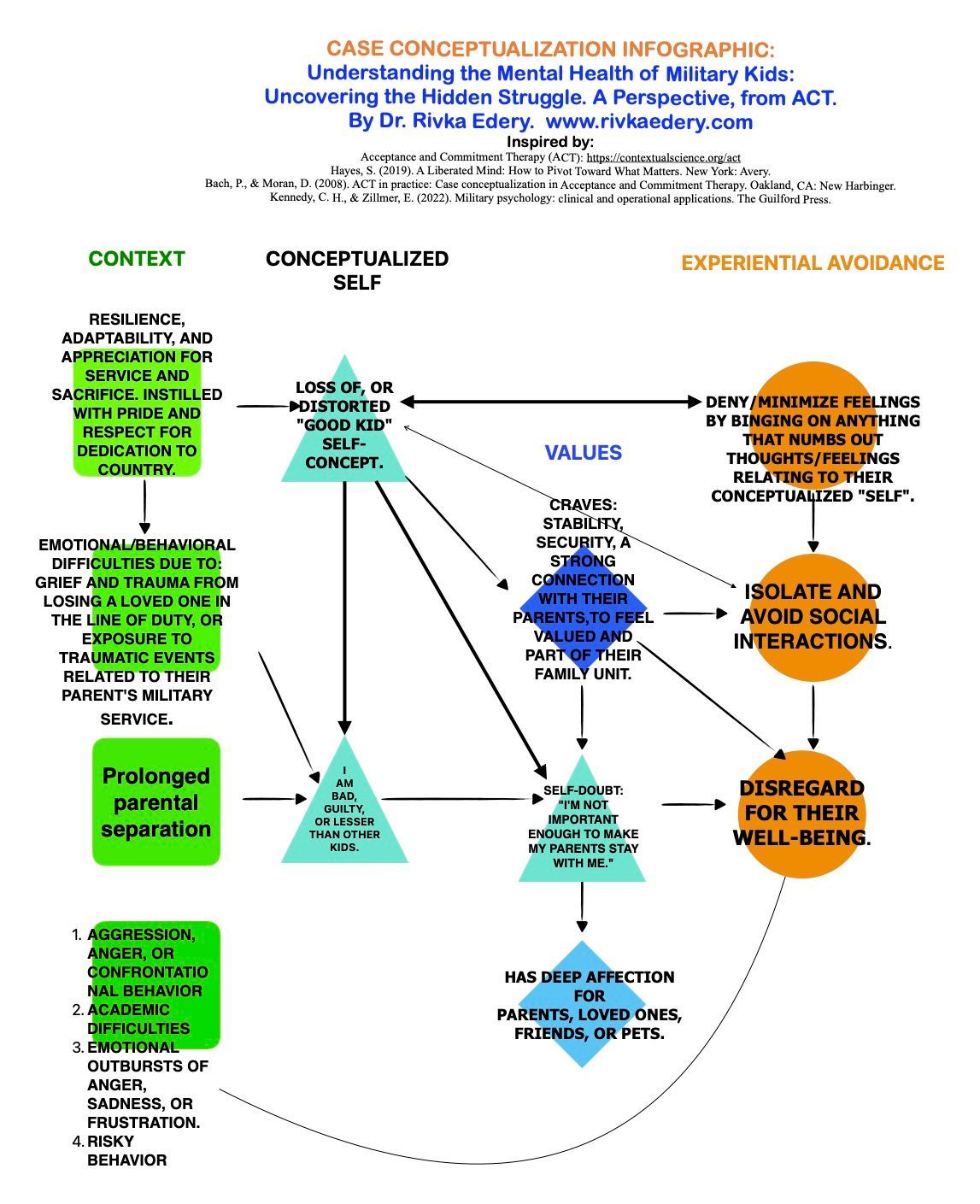
CASE CONCEPTUALIZATION INFOGRAPHIC:
Unveiling the Hidden Struggles: Understanding the Emotional Challenges of Military Kids.
A Perspective, from ACT (Acceptance and Commitment Therapy).
By: Dr. Rivka Edery. www.rivkaedery.com
Inspired by:
Acceptance and Commitment Therapy (ACT): https://contextualscience.org/act
Hayes, S. (2019). A Liberated Mind: How to Pivot Toward What Matters. New York: Avery.
Bach, P., & Moran, D. (2008). ACT in practice: Case conceptualization in Acceptance and Commitment Therapy. Oakland, CA: New Harbinger.
Kennedy, C. H., & Zillmer, E. (2022). Military psychology: clinical and operational applications. The Guilford Press.
Military kids face emotional challenges, such as moving away from deployed parents, adjusting to new schools, and coping with the unpredictability of military life. This can lead to isolation and instability, but support systems are available to help. ACT may be a helpful tool for these children.
1. Separation and Loss: Military children often experience prolonged separations from their parents because of deployments, which can lead to feelings of sadness, loneliness, and missing their loved ones.
2. Relocation Stress: Frequent moves can disrupt stability, causing military kids to struggle with leaving friends, adjusting to new schools and communities, and feeling like outsiders.
3. Anxiety and Uncertainty: The unpredictable nature of military life, such as deployments and potential dangers, can create anxiety and stress for children who worry about their parent's safety or the future.
4. Grief and Trauma: Military kids may experience grief and trauma if they have lost a loved one in the line of duty or exposed to traumatic events related to their parent's military service.
5. Identity and Belonging: Military children often grapple with questions of identity and belonging as they navigate multiple cultures, adapt to different environments, and sometimes feel disconnected from their civilian peers.
Not all military children will experience these issues to the same extent, as resilience and coping strategies can vary from child to child. Support systems, such as military family programs, counseling services, and connecting with other military families, can help address these emotional challenges.
We can use the case conceptualization infographic on the mental health of military kids in various ways:
1. Awareness and Education: Share the infographic with military families, educators, mental health professionals, and community organizations to increase awareness about the emotional challenges of military children. It can help promote understanding and empathy for their unique experiences.
2. Identification and Assessment: Use the infographic as a reference tool to identify and assess the emotional issues that military children may be facing. It can be a starting point for conversations with children, parents, and professionals involved in their care.
3. Treatment and Intervention: The infographic highlights the core emotional issues military kids may encounter. Mental health professionals can use this information to develop treatment plans and interventions tailored to the specific needs of military children. ACT (Acceptance and Commitment Therapy) is helpful, so professionals can explore incorporating ACT techniques into their work with these children.
4. Support and Resources: The infographic emphasizes the importance of support systems for military children. Please share it with military family programs, counseling services, and other relevant organizations to enhance their understanding of military kids' challenges and to guide the development of resources and support networks.
Overall, this infographic serves as a valuable tool for raising awareness, understanding, and supporting the mental well-being of military children.
To learn more about Acceptance and Commitment Therapy (ACT), please visit https://contextualscience.org/act
To learn more about my work, please visit: http://www.rivkaedery.com/
INFOGRAPHIC:
Understanding the Mental Health of Military Personnel; Uncovering the Hidden Struggle. A Perspective, from ACT.
By Dr. Rivka Edery
The purpose of my infographic is to educate people on the health issues that can arise from deployment and stress in the military. It explores aspects such as injury, loss of self-identity, values, and avoiding complex experiences. Substance abuse, infidelity, anger, stress, communication problems, and suicidal thoughts are some behaviors illustrated. It also acknowledges the feelings of detachment, loneliness, and isolation that arise from experiences. ACT could be a way to handle these problems.
We can use this infographic in the following ways.
1. Education. It helps to understand the mental health obstacles that military members encounter on active duty and as veterans.
2. Training. Therapists can use it to understand the needs and experiences of personnel.
3. Counseling/Therapy. During therapy, therapists can use it to assist service members and veterans in recognizing and sharing their inner world.
4. Advocacy: Advocates can use it to raise awareness and advocate for necessary resources and support.
5. Research: Researchers investigating health within contexts can use it as a reference point for further exploration.
Remember, using this tool ethically while respecting the information it encompasses is crucial.
ABOUT Dr. Rivka Edery
As a social worker, doctor of psychology and published author, I have extensive experience in behavioral health. I use a trauma-informed approach to therapy, focusing on attachment and helping clients make life choices based on their values. I provide counseling services for individuals, families, and couples to promote psychological flexibility.
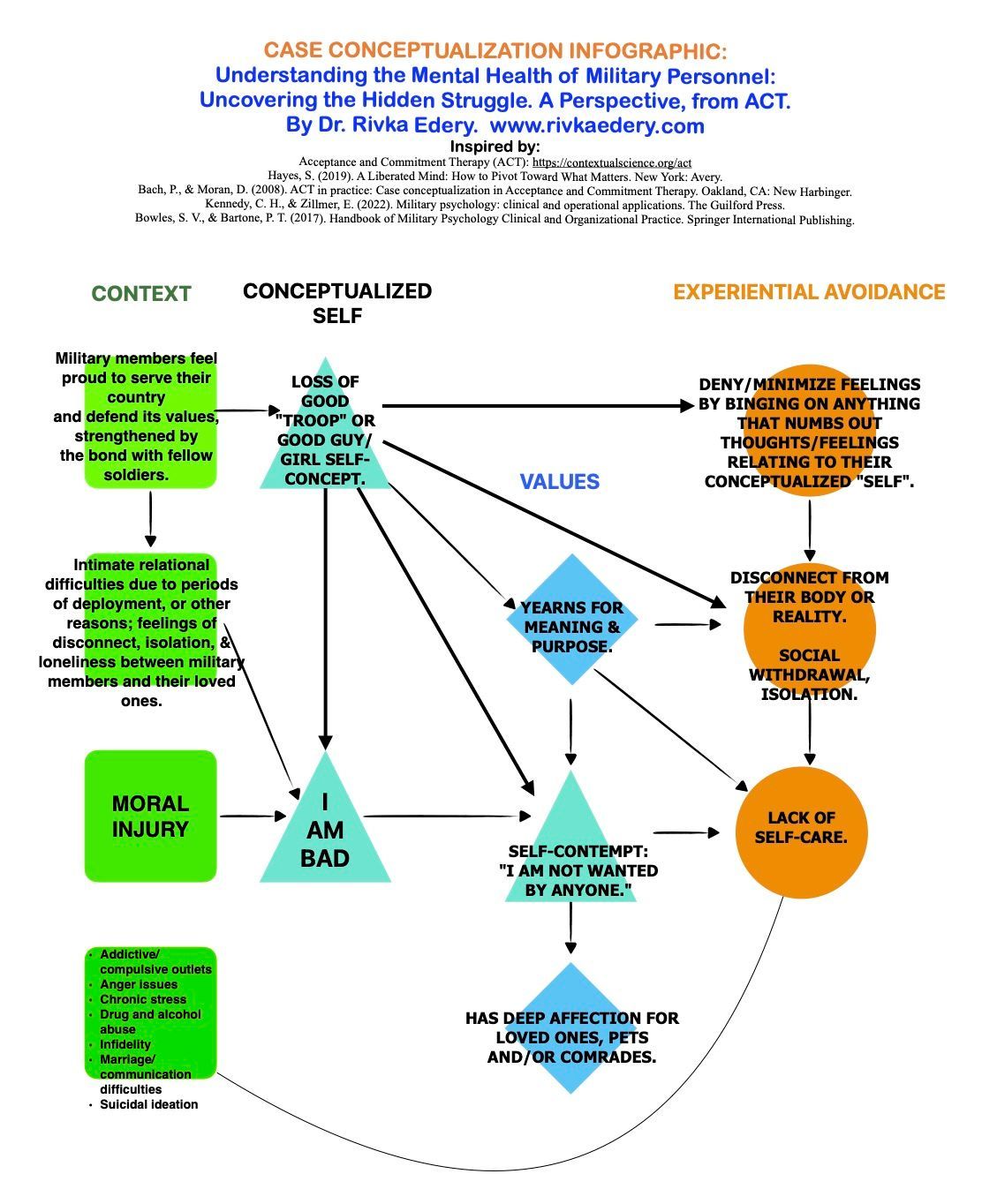
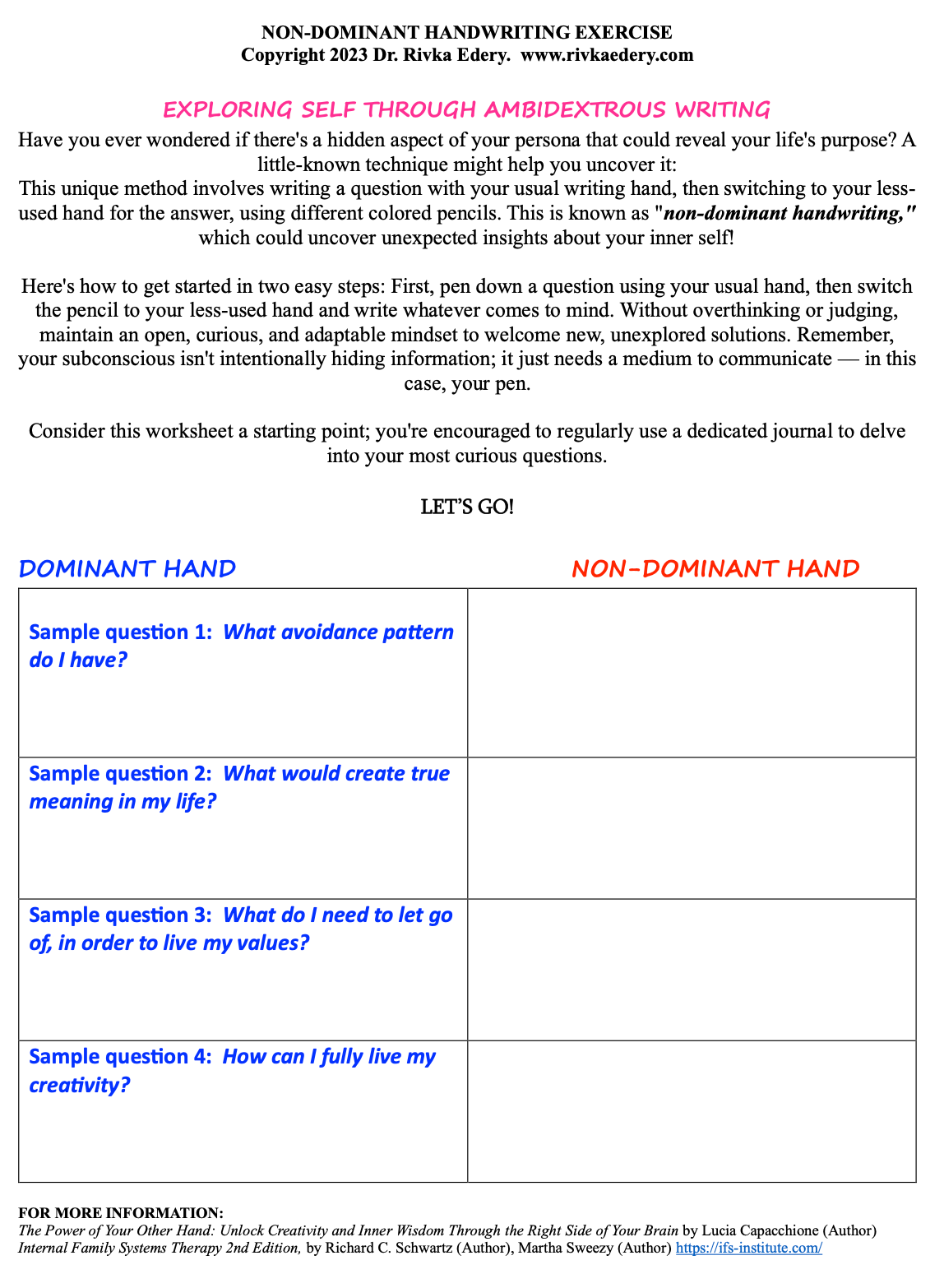
Cognitive defusion is a concept from Acceptance and Commitment Therapy (ACT) that relates to how we interact with our thoughts. The process encourages us to create distance from our thoughts, reducing their impact and influence on our actions. Instead of accepting our thoughts as literal truths, cognitive defusion encourages us to observe them as just thoughts. They are devoid of any inherent power over us.
Cognitive fusion is when we become entangled with our thoughts and see them as reality. This can limit our ability to respond effectively to life's challenges.
The technique of non-dominant handwriting can help with cognitive fusion in several ways. By using our non-dominant hand to write, we naturally slow down our thought process. This allows us more time to observe our thoughts rather than immediately reacting to them, promoting cognitive defusion.
Writing with your non-dominant hand can give you a new way of thinking about familiar thoughts.. It encourages us to see them as separate from ourselves. By visually representing the separation caused by cognitive defusion, it helps us accept our thoughts don't define us.
This technique can help us overcome our thoughts and become more adaptable in our behaviors..
Here's to defusing from troubling thoughts that might bully you around!
You can either download it from this post, or email me for a copy: redery@rivkaedery.com
Have fun with ambidextrous writing!
-Dr. Rivka
#NonDominantHandwriting
#CognitiveDefusion
#ACT
#Mindfulness
#SelfExploration
#SubconsciousMind
#MentalWellness
#ThoughtDetachment
#CreativeTherapy
#WritingTherapy
#AmbidextrousWriting
#PersonalGrowth
#ThoughtAwareness
#MentalAgility
#EmotionalResilience
#InnerPeace
Curious About Parts:
Finding Solutions Through Non-Dominant Handwriting Exploration.
Dr. Rivka A. Edery, Psy.D., M.S.W., L.C.S.W., CCTP-II, CAIMHP, CSTS, M-RAS
Creative Reparenting can transform broken mirrors into beautiful mosaics.
Email: redery@rivkaedery.com
Website: www.rivkaedery.com
Hello, my name is Rivka. I am a Doctor of Psychology, Licensed Clinical Social Worker, and published author with multiple behavioral health certifications. To learn more about me and my work, please visit my website at www.rivkaedery.com
Listen on YouTube: https://youtu.be/Ag639TgiXo4
CURIOUS ABOUT PARTS
INTRODUCTION
A glance at a page written by a left-handed person may catch one off-guard with its unique and unusual appearance. The slant of the text, the ink on the page, and even the style of the letters themselves are the work of a completely different person. They are the work of a completely other hand. Left-handed people have been forced to adapt to a world built for right-handed people, especially when it comes to writing, and this has led to the development of a unique form of handwriting known as 'non-dominant handwriting.
If you're intrigued by the world of non-dominant handwriting, I encourage you to try it. Grab a pen, paper, and embark on a journey of self-expression through a different hand. With time and practice, you'll unlock new possibilities and find joy in this unique form of writing.
The world of non-dominant handwriting offers a fascinating and rewarding exploration for anyone willing to step outside their comfort zone. It's an opportunity to appreciate the unique beauty and challenges left-handed individuals face in writing. By trying non-dominant handwriting, you can gain a deeper understanding of the adaptability and resilience of left-handed individuals.
Remember, approaching this technique with an open mind, curiosity, patience, and consistent practice is critical to making the most out of it. Take inspiration from the case study of my client, 'Sam,' who discovered new possibilities and self-expression through non-dominant handwriting.
So, why not pick up a pen, grab some paper, and embark on your journey of self-discovery and creativity? Through practice and dedication, you'll develop a unique form of handwriting and unlock a new level of personal fulfillment and joy.
Remember, the power of non-dominant handwriting lies in your hands.
Let's begin with five questions on this technique that I will answer in this article. Approaching this technique with an open mind, curiosity, patience, and consistent practice is essential for making the most out of it.
1. How does non-dominant handwriting facilitate parts exploration that might be less accessible?
2. What advantages are there in engaging with your vulnerable parts using non-dominant handwriting?
3. In what ways does non-dominant handwriting enhance psychological flexibility?
4. What might be some examples of robust solutions within parts of yourself that are out of reach?
5. What advantages arise from utilizing non-dominant handwriting to establish a connection with various aspects of oneself?
PREPARATION: FIVE STEPS.
To start, let's extend a warm welcome to any parts that might seek expression.
1. Creating a comfortable environment with a smooth writing surface and minimal distractions is essential to get the most out of these exercises.
2. Divide a sheet of paper into two columns. On the left column, write the question with your dominant hand. Transfer the pen to your non-dominant hand, and in the right column, write the answer. Try not to judge or edit yourself. The writing and language will sound different from your regular voice. This approach unlocks opportunities for exploring novel ideas and accessing deep emotions.
3. Start with brief sessions, extending the duration as you grow more comfortable and acquainted with the process.
4. Direct your focus towards any thoughts, emotions, or memories that arise. Imagine placing negative judgments on leaves in a stream and letting them float away.
5. It's essential to seek professional guidance when dealing with emotional difficulties. Consider contacting a therapist if you need support.
THE FIRST QUESTION
How does non-dominant handwriting facilitate parts exploration that might be less accessible?
We are multi-modal (not just one mind). Identifying the influences of different parts of your mind has a few key benefits. A prime example is decision-making. Knowing these influences gives you the power to choose. Non-dominant handwriting is one method that can help you access these less visible parts of yourself.
Have you ever experienced sudden insights or inspiration? It could be your pre-conscious mind at work. Would you be interested in discovering how to tap into this hidden realm of your mind?
Take a moment to think about how your unconscious mind affects your emotions, dreams, and automatic behaviors.
Do you notice any patterns or recurring themes in these areas of your life?
Have you observed any internal conflicts or contradictions? Exploring the various facets of your mind can help you comprehend and reconcile these opposing parts. Do you feel more connected to certain parts, disconnected from others?
CLIENT 'SAM': A STUDY OF THE FIVE CRUCIAL QUESTIONS
I will use a case study featuring my client 'Sam' to answer the following questions.
THE SECOND QUESTION
What advantages are there in engaging with your vulnerable parts using non-dominant handwriting?
I helped a client named Sam struggling with a recurring romantic issue. At first, Sam seemed like a desirable partner. His partners described him as 'charming, intelligent, engaged, and affectionate.' However, he would always pull away after a short time in every new relationship. Despite being middle-aged, Sam felt confused about why he kept repeating his actions, keeping him single and childless. He spoke well of his partners, with a biased slant towards self-critical blaming.
During this process of non-dominant handwriting, he connected with an inner child who expressed the need to approach and withdraw to avoid his fear of abandonment and lack of trust. Through this cathartic experience, Sam could awaken a vulnerability he had been fearfully avoiding for a long time. He even showed me his tear-stained handwriting. After several more sessions and many pages of journaling, Sam felt more connected to his inner child and had less of a need to avoid intimacy. He overcame his fear of abandonment by expressing it through his non-dominant hand, giving his younger self a new voice.
I aided him in the following ways:
1. I suggested Sam keep up with his journaling as it had brought him positive results using his non-dominant hand. This practice can aid him in exploring and connecting with his inner child and continuing the healing process.
2. I assisted Sam in understanding and accepting his emotions. He opened up about his fear of abandonment and issues with trust, which I recognized as valid emotions based on his experiences. I reassured him that feeling vulnerable or scared in relationships is entirely normal.
3. I assisted Sam in comprehending his attachment style, which was a Disorganized (Fearful-Avoidant) attachment style, and its strong impact on his romantic relationships. The results of the attachment style assessment offered valuable insights into his behavior, empowering him to cultivate more profound and more constructive relationships with those in his life.
4. I advised Sam to cultivate self-compassion as he moves on his healing journey. I encouraged him to understand that healing and developing new habits takes time and setbacks are natural. He must be patient and gentle with himself.
5. Sam has been seeking my guidance for ongoing therapy as he often experiences emotional overwhelm. He needs support to address his disorganized attachment issues.
THE THIRD QUESTION
How can non-dominant handwriting increase your psychological flexibility?
The emotions, memories, sensations, and experiences of Sam were evident in his non-dominant handwriting.
Using this technique, he could communicate with parts of himself that he may not have been able to reach otherwise. By bypassing his protector/manager parts, which often prevent him from being vulnerable and open, he uncovered aspects of himself that he may have overlooked. This innovative approach allowed him to connect with the parts of himself that had been neglected.
Sam discovered he was avoiding relationships due to his fear of abandonment. He confronted this fear directly, which helped him feel more stable. Sam concentrated on identifying the underlying reasons for his trust issues to address them. He began by requesting additional details from his younger self to understand better and develop mindfulness.
I helped Sam identify recurring patterns or themes that arise when he feels vulnerable or hesitant toward intimacy. By recognizing these thoughts or beliefs, he became more psychologically flexible and better able to address them.
Sam discovered tear-stained marks on his journal pages during our sessions and permitted himself to grieve. He felt secure and open, enabling him to express his emotions and share his experiences. Crying played a vital role in his journey toward healing, and he felt at ease enough to let his emotions flow freely.
He wrote with his non-dominant hand to connect with his inner child. Surprisingly, his pen produced abundant knowledge, wisdom, love, and sweet words. He used the insights and solutions gained from this practice to find answers to lifelong questions that had been troubling him. This helped him to focus on his values and move away from chronic avoidance and superficial engagement with life.
As he became more relaxed and connected, he developed a more loving and intimate relationship with the parts of himself that were sending him information. These parts communicate their experiences through thoughts, emotions, and bodily sensations.
THE FOURTH QUESTION
What might be some examples of robust solutions within parts of yourself that are out of reach?
It sounds like Sam is going through a tough time. He's been trying different self-help techniques to deal with his disconnection but hasn't found a lasting solution. I understand that exploring childhood or family dynamics can be difficult, but it may be helpful in understanding where his struggle is coming from. The critical voice from his parent must have been very hurtful and dismissive of his pain. Sam needs to know that his feelings are valid and that he deserves to be heard and supported.
I empathically validated Sam's chief complaint:
1. You may experience a feeling of disconnection with yourself and find it challenging to connect with others. This disconnect prevents clarity and certainty about your own identity.
2. Even though you've tried various self-help methods, the feeling of disconnection still lingers underneath.
3. Your unconscious narrative patterns originate from various aspects of your psyche. They can impact your behavior, perceptions, and understanding of the world.
4. Unconscious habits can appear as recurring patterns or psychological tendencies. Despite your efforts to resist them, they may persist and seem to act independently (known as repetition compulsion).
5. The Internal Family Systems (IFS) model is a helpful approach that involves identifying and nurturing the different parts within oneself. By recognizing these parts and their needs, one can develop a more loving and nurturing inner parent, leading to healthier ways of relating to oneself and others.
6. Using non-dominant handwriting can help change the dynamics between different parts of yourself. It provides a safe and secure space to let go of burdens, build loving relationships, and tap into your fullest potential.
Sam came to realize the importance of recognizing unconscious patterns. The initial stage of progress and recuperation begins with self-awareness. Techniques such as non-dominant handwriting, ACT (Acceptance and Commitment Therapy), Polyvagal Theory, and the IFS model significantly aided him.
To prompt Sam's deeper reflection, we used the following four cues:
1. Do I engage in repetitive behaviors that cause me to feel disconnected?
2. I note the moments that bring me joy, keep me grounded or make me feel connected. These moments, which I call "glimmers," differ from when I feel disconnected.
3. I am reflecting on how my thoughts and emotions are connected and exploring different parts of myself, including my multi-faceted mind. I question whether I hide or suppress certain aspects of my identity. Instead, I am trying to accept and recognize all of the different parts of myself, bringing them to my conscious awareness. This approach will lead to greater overall well-being.
4. I am ready to be a compassionate inner parent who can support and understand my younger parts, including exiles, protectors, and managers. This internal parenting dynamic can benefit me by spreading love and kindness to them.
CASE REVIEW
When analyzing this case, we need to consider any potential cognitive biases that might affect our assessment of the client's experience and the usefulness of non-dominant handwriting as a therapeutic technique. For example, investigating other factors contributing to the client's persistent romantic problem is vital.
As we looked into the matter, we found that my client, Sam, displayed confirmation bias. This means that he tended to interpret information in a way that confirmed his existing beliefs or expectations. For instance, Sam believed that his behavior answered his relationship troubles. However, his "problems" were symptoms of anxiety caused by his fear of being left alone. His approach of withdrawing or avoiding was a temporary fix that needed to be more sustainable in the long run. This mindset was reflected in his non-dominant handwriting. It's important to note that such bias can restrict one's outlook and prevent the exploration of other factors that may contribute to the problem.
There is a cognitive bias called the self-serving bias, which involves attributing positive outcomes to internal factors and adverse effects to external factors. In the case of Sam, his success was due to his willingness to explore his inner child. However, he may become overly self-focused and must pay more attention to other essential factors.
When discussing Sam's romantic partners, it's important to remember his biases, particularly his confirmation bias. Sam's cognitive biases, which include confirmation bias, can affect how he portrays his partners. Biases can lead people to focus on the favorable qualities of their choices.
To avoid the adverse effects of cognitive biases, it is essential to approach information with a skeptical yet open-minded attitude. Sam revealed his childhood fears through his non-dominant handwriting. He needed to recognize other factors that may contribute to his difficulties in romantic relationships.
It's essential to be mindful of cognitive biases to achieve better therapy outcomes. Overcoming these biases can be done by exploring alternative explanations from a place of kindness, empathy, and up-to-date information. By doing so, a clearer understanding of the situation can be developed.
Using this method can lead to a more precise evaluation of the advantages of non-dominant handwriting.
THE FIFTH QUESTION
What advantages arise from utilizing non-dominant handwriting to establish a connection with various aspects of oneself?
Think of a current issue that is causing you distress. Write the title of your dilemma on a sheet of paper. It can be anything that is troubling you. Using your dominant hand, write the question and direct it to: "The part (s) of me that would like to speak about this."
Take a different colored pen or pencil in your non-dominant hand, set the timer for five or ten minutes, and start writing! It may feel awkward, your handwriting may be difficult to read, and the language might sound juvenile. After reviewing the answer, take the pen in your dominant hand and thank that part for coming forward and providing a solution. Repeat until you know which part of you emerged first, what advice you received, and what potential action steps you might need.
AFTER THE WRITING SESSION
1. Pause momentarily and reflect upon the initial unease or resistance you may have encountered during this exercise. How could embracing this discomfort create pathways for new opportunities and personal growth?
2. Explore the language and tone of the non-dominant handwriting. How does it differ from your usual way of expressing yourself? What insights can you gather from the childlike language and writing style? How might this young perspective offer fresh insights or untapped wisdom?
3. Consider the part of you that first came forward. Reflect on its message and guidance. How does this part relate to your current issue or dilemma? What emotions or needs does it represent? How might acknowledging and honoring this part contribute to your overall well-being?
4. Pause and assess the suggested action steps from your writing. How do these steps differ from your typical approach? What fears or resistance might arise as you consider these actions? In what manner can stepping outside of your comfort zone and embracing these actions unlock new possibilities and foster personal growth?
5. Reflect on the overall experience. Would you try it again: why or why not?
POTENTIAL BENEFITS OF NON-DOMINANT HANDWRITING
1. Contemplate the unresolved aspects of your life. Which issues or discomforts could your writing assist you in addressing? How might non-dominant writing facilitate growth and transformation, offering benefits for personal development?
2. In what ways can this practice enable you to perceive your current issues or dilemmas from a different perspective? What novel insights or possibilities may emerge when you grant your parts the opportunity to express themselves through this unconventional method?
3. Consider releasing the stories held by your parts through non-dominant handwriting. What stories or burdens do your parts carry, and what are they telling you? How can writing these stories offer a pathway to unburdening yourself and crafting a fresh narrative for personal growth and transformation?
4. Explore connecting with your core values through non-dominant handwriting. How might this practice help you align with your cherished values? What potential shifts or transformations might occur as you listen to and validate the truths expressed by your parts?
5. What can you learn from this practice? How can you apply this newfound understanding for committed action?
CONCLUSION
Embrace the journey of self-discovery: Through non-dominant handwriting, you can uncover hidden aspects of yourself and reconnect with your inner world. Embrace this journey and allow yourself to explore the depths of your being. Connect with your unconscious mind: Non-dominant handwriting provides a unique pathway to tap into your unconscious mind. By allowing your non-dominant hand to express itself, you can access more profound thoughts, emotions, and insights that may have been hidden or ignored.
Engaging in non-dominant handwriting only requires specific skills or knowledge other than rudimentary reading and writing. A consistent practice offers valuable, meaningful rewards. These rewards can manifest in self-awareness, personal growth, emotional healing, and a deeper understanding of oneself. Each individual is unique, so finding what works best for you is essential. Experiment with different techniques, explore various writing prompts or exercises and adapt the practice to suit your needs and preferences. Make it a personalized journey of self-expression.
Cultivate compassion and empathy. The process of non-dominant handwriting can be an act of self-compassion and empathy towards oneself and others. As you engage in this practice, remember to approach it with kindness and understanding. Allow yourself to be gentle with any emotions or experiences that arise and extend that same compassion to others on their journey of self-discovery.
Take care of your nervous system. Engaging in non-dominant handwriting can have a calming and soothing effect on your nervous system. It provides a creative outlet to release pent-up emotions or stress. Make it a regular self-care routine, and notice how it positively impacts your well-being.
Trust the process. The beauty of non-dominant handwriting lies in its ability to surprise and reveal aspects of yourself that you may not have been aware of. Trust the process and allow it to unfold naturally. Be open to the insights and revelations from this practice, as they can lead to personal growth and transformation.
To sum up, non-dominant handwriting offers benefits beyond improving skills and gaining knowledge. It can be a powerful tool for self-discovery, fostering psychological flexibility, connecting with the unconscious mind, and cultivating compassionate empathy. Embrace the journey, personalize it to fit your needs, and you will witness the many rewards it can bring.
I hope you enjoyed this article.
Thank you for taking the time today. To learn more about me and my work, please visit my website: www.rivkaedery.com.
Dr. Rivka A. Edery, Psy.D., M.S.W., L.C.S.W., CCTP-II, CAIMHP, CSTS, M-RAS
SOURCES USED
Anderson MD, Frank G, Sweezy M, Schwartz RC. (2017). Internal Family Systems Skills Training Manual: Trauma-Informed Treatment for Anxiety, Depression, PTSD & Substance Abuse. PESI Publishing & Media.
Anderson, F.G. (2021). Transcending trauma: Healing complex PTSD with internal family systems. Claire, WI: PESI Publishing.
Capacchione, L. (2019). Power of Your Other Hand. Red Wheel Weiser.
Earley, J. (2013). Freedom from your inner critic: A self-therapy approach. Louisville, CO: Sounds True.
Earley, J. (2012). Self-therapy: A step-by-step guide to creating wholeness and healing your inner child using IFS, a new, cutting-edge psychotherapy (2nd ed.). Larkspur, CA: Pattern System Books.
Harris, R. (2011). The Confidence Gap: A Guide to Overcoming Fear and Self-Doubt. Boston, MA: Trumpeter Books.
Harris, R. (2019). ACT Made Simple: An Easy-To-Read Primer on Acceptance and Commitment Therapy (Second Edition)—New Harbinger Publications.
Harris, R. (2021). Trauma-Focused ACT: A Practitioner's Guide to Working with Mind, Body, and Emotion Using Acceptance and Commitment Therapy. Oakland, CA: Context Press.
Harris, R. (2023). ACT with Love: Stop Struggling, Reconcile Differences, and Strengthen Your Relationship with Acceptance and Commitment Therapy.—New Harbinger Publications.
Hayes, S. (2019). A Liberated Mind: How to Pivot Toward What Matters. New York: Avery.
Hayes, S. C. (2020). Acceptance and Commitment Therapy: Principles of Becoming More Flexible, Effective, and Fulfilled. Louisville, CO: Sounds True.
Philip BA, Frey SH. (2016). Increased functional connectivity between cortical hand areas and praxis network associated with training-related improvements in non-dominant hand precision drawing. Neuropsychologia. Jul 1;87:157-168. doi: 10.1016/j.neuropsychologia.2016.05.016. Epub PMID: 27212059; PMCID: PMC4903896.
Schwartz, R.C. (2023). Introduction to the internal family systems model. Louisville, CO: Sounds True. (Original work published 2001).
Schwartz, R.C. (2023). You are the one you've been waiting for, bringing courageous love to intimate relationships. Louisville, CO: Sounds True. (Original work published 2008).
Schwartz, R.C. (2020) No bad parts. Louisville, CO: Sounds True.
Hayes, S. C. (2020). Acceptance and Commitment Therapy: Principles of Becoming More Flexible, Effective, and Fulfilled. Louisville, CO: Sounds True.
Philip BA, Frey SH. (2016). Increased functional connectivity between cortical hand areas and praxis network associated with training-related improvements in non-dominant hand precision drawing. Neuropsychologia. Jul 1;87:157-168. doi: 10.1016/j.neuropsychologia.2016.05.016. Epub PMID: 27212059; PMCID: PMC4903896.
Schwartz, R.C. (2023). Introduction to the internal family systems model. Louisville, CO: Sounds True. (Original work published 2001).
Schwartz, R.C. (2023). You are the one you've been waiting for, Bringing courageous love to intimate relationships. Louisville, CO: Sounds True. (Original work published 2008).
Schwartz, R.C. (2020) No bad parts. Louisville, CO: Sounds True.
HELP YOUR YOUNG PARTS FIND THEIR WAY HOME:
GUIDED INNER CHILD REPARENTING PRACTICE FOR DEVELOPMENTAL TRAUMA.
By: Dr. Rivka Edery
Listen on YouTube: https://youtu.be/kDstpjqajXI
INTRODUCTION
Welcome to a guided meditation designed to help you connect with your inner child and other parts of yourself. These parts comprise your inner family and may contain raw emotions, beliefs, and roles stemming from past trauma, grief, loss, or neglect. This meditation aims to help you tune in to these parts as the Safe One, a loving and kind parent figure who can provide the support you may have lacked as a child. Unfortunately, some children are born into families with inflexible or dangerous parents, which can be traumatic. By showing up for your inner child now, you can create a healing and loving relationship that can benefit you today. If you experienced abuse or trauma in childhood, this meditation can provide a safe space to process any unprocessed pain, shame, or grief. I hope this guided meditation helps you find relaxation and healing within yourself.
First, make sure you are in a comfortable position. Take this time to focus on yourself, starting by paying attention to your breathing.
Stay in the present moment and avoid thinking about the past or future. For now, focus on the present.
Embrace your true self, which includes your kind and caring nature. Treat yourself with the same level of care and attention you would give your vulnerable parts if you were your ideal parent. Whenever thoughts, feelings, memories, or physical sensations arise, approach them kindly. They may contain important information and wisdom about yourself.
Lastly, invite your Safe One, an inner parent figure who loves and protects you, to join you as you explore your inner self.
As you welcome all parts of yourself, it is important to maintain a neutral and safe space. Avoid judgment or self-importance, and instead offer loving kindness to all aspects of you. These parts are vulnerable and carry both trauma and wisdom. They yearn for your affection and guidance, hoping to be the nurturing parent they never had. You are the only one who can fulfill this role.
Take a moment to identify any emotions that are stirred within you. Do you have a part that is constantly alert, guarding your vulnerability? Take a moment to reflect on this part's age and any unresolved issues they may have.
With the Safe One activated, you will lean towards an open and connected state, spreading safe, loving, kind energy to all your parts. This will help bring you peace, love, and calm for a few gentle moments.
GUIDED VISUALIZATION
Imagine yourself walking down a beautiful path surrounded by lush green pastures. The weather is perfect, and there isn't a cloud in the sky. You feel safe, calm, and at perfect rest, enjoying the gentle breeze and taking deep breaths. Perhaps you're even humming your favorite tune. As you continue walking, you become more and more filled with deep, spiritual love and a sense of unity. With each step you take, you grow in loving parent energy for all the young, tender, and vulnerable aspects within you. This is your essence - empathic, kind, curious, gentle, and confident. Let's continue down this path together, embracing our inner Safe One.
Imagine that there is a younger version of yourself who needs your help. This child version of you is waiting for you close enough. You can see them and confidently walk towards them. You are the only one who can truly understand and love this child-self, as only you know all their secrets, fears, hidden joys, and needs. This special relationship has the potential to heal you on the deepest levels.
As you approach your inner child, your heart fills with love and kindness. When you finally stand before them, please take a moment to understand their feelings without trying to change or fix them. Your presence is all they need.
Welcome your inner child into your heart and introduce yourself as their grown-up self. Ensure you are strong, wise, capable, resourceful, loving, and connected. Let them know you are happy they are here and offer warm love and support. Ask what they need, such as revisiting a specific memory from childhood. Accompany them on this journey without judgment. Your only intention is to love and support them.
Be mindful of their feelings, thoughts, and expressions throughout the scene. Let them know that your compassionate presence is always there for them and that you will never leave. Apologize for not being there in the past and express your desire to build a safe and trusting relationship with them. As their loving parent, offer them attention and care. This is a moment to heal and release your inner family's burdens.
Your inner parts may still be stuck in a frozen state due to unprocessed trauma, causing you to feel younger than you are. Taking the time to care for your inner family is important, starting with a kind and compassionate presence.
Once you've addressed the situation, offer to guide your inner child back down the path you came from, taking breaks for eye contact, hugs, and holding hands. As you embrace your vulnerabilities as a Safe Inner Parent, you'll experience peace and joy.
As you reach the end of your journey, take a moment to connect with your inner child. Ask them again what they need and reassure them that you can fulfill any big or small request. Express gratitude for their presence and trust, and tell them you care for them deeply. Promise to revisit them soon.
Slowly open your eyes and return to the center. Take a few deep breaths, feeling reassured that you are secure and in touch.
I hope you enjoyed this guided meditation. To download this meditation, click on the Google Drive file:
https://drive.google.com/file/d/1vh0VBqzUUONuzjSOlF7y6NwDFVSkVGX9/view?usp=drive_link
To learn more about me and my work, visit: www.rivkaedery.com
To listen on YouTube: https://youtu.be/kDstpjqajXI
The Power of Values in healing severe childhood trauma: Three creative writing exercises.
Dr. Rivka A. Edery, Psy.D., M.S.W., L.C.S.W., CCTP-II, CAIMHP, CSTS, M-RAS
Creative Reparenting can transform broken mirrors into beautiful mosaics.
Email: redery@rivkaedery.com Website: www.rivkaedery.com
Listen to this on YouTube: https://youtu.be/y6JmVjVJ3Dk
Hello, my name is Rivka. I am a Doctor of Psychology, Licensed Clinical Social Worker, and published author with multiple behavioral health certifications.
This article aims to assist individuals in exploring their values through creative writing exercises. It is tailored to adult survivors of severe childhood abuse and anyone interested in self-discovery and personal exploration. The activities provided are designed to encourage deeper exploration and help individuals overcome disconnection and avoidance. This disconnection can be uncomfortable and unsettling for people of any age or life stage. Still, it can feel like a necessary and constant survival strategy for those who have suffered early childhood trauma. It's similar to a writer staring at a blank page, wondering where to start or how to proceed without a clear sense of purpose. To combat this uncertainty, I have developed three questions with multiple sub-questions for you to try. Feel free to add them to your toolbox if you find them helpful. If not, consider revisiting them later, sharing them with a friend, or relying on your wisdom to see what's right for you.
The first question is intended to tap into your creative side, activating the right hemisphere of your brain. The second question will engage your analytical left brain. Finally, the third question will challenge you to utilize both sides of your brain harmoniously and synergistically. Let us begin!
In preparation, explore these three writing prompts to stimulate your creative and logical faculties. When delving into your inner thoughts, engaging both sides of your brain nurtures enhanced internal collaboration, yielding more effective outcomes.
1. Creative Side (Right Brain Activation):
Imagine you are in a beautiful, serene garden. Close your eyes and visualize the vibrant colors, the scent of blooming flowers, and the gentle rustling of leaves. As you explore this garden, you stumble upon a hidden treasure chest. Please describe what you find inside and the emotions it evokes within you. Write a short story, poem, or song inspired by this discovery.
2. Analytical Side (Left Brain Engagement):
Think about a personal value that you hold dear. It could be something like honesty, compassion, or perseverance. Reflect on why this value is important and how it influences your actions and decisions. Please write an essay exploring the origins of this value in your life, any experiences that have reinforced its significance, and how it shapes your character.
3. Harmonious Synthesis (Both Brain Utilization):
Imagine you are standing on a hill that overlooks a bustling city skyline. As you observe the vibrant cityscape, you notice a particular building that catches your attention. This building represents a cause or issue that you are passionate about. Using your creative and analytical skills, create a persuasive speech or letter advocating for positive change regarding this cause. Incorporate logical arguments, emotional appeals, and innovative storytelling techniques to convey your message effectively.
Now, let's examine the significance of your life, considering that a meaningful existence gives life its value.
Question One (Four Prompts).
Imagine standing before a large, empty book representing your life. You are both the author and reader of your story. Suppose you could re-tell your life's story without negative influences and only use empathetic love and wisdom. How would you choose to re-write it?
1. Reflect on your childhood: Think about the people, places, and experiences that have shaped who you are today. Consider key moments, influential figures, and any defining characteristics or traits that have played a significant role in your life story.
2. Identify your passions and interests: What activities or topics have always sparked your curiosity and enthusiasm? These include hobbies, academic subjects, social causes, or creative pursuits. Explore how these interests have evolved and how they contribute to your personal growth.
3. Consider your goals and aspirations: What do you hope to achieve or experience in your lifetime? These goals can encompass various areas, such as career, relationships, personal development, or travel. Reflect on how these aspirations motivate and drive you forward in your life's narrative.
4. Reflect on significant relationships: Think about the people who have had a profound impact on your life, whether they are family, friends, mentors, or even fictional characters. Explore the dynamics of these relationships, the lessons learned, and how they have shaped your identity.
Question Two (Six Prompts).
Who is responsible for narrating your life story?
Values can be likened to a puzzle, each representing a specific aspect requiring crucial decision-making. This puzzle contains numerous riddles that need solving. For example, are hidden parts of your life obscured by dark curtains or locked away in an inaccessible vault? Are you actively pursuing your creative passions? What "voice" do you use to motivate yourself (the Loving Inner Parent or the Critical Parent voice)? These riddles can bring about anxiety as they trigger the fear of the unknown within yourself. However, they can also help you identify what you may be avoiding and guide you toward a value-driven life.
1. Reflect on your self-narrative: Consider who narrates your life story. Are you the author, or do external influences play a significant role? Reflect on how you perceive your agency and the power of societal expectations, cultural norms, or past experiences in shaping your self-narrative.
2. Uncover hidden parts of your life: Explore whether aspects of your life remain obscured or inaccessible to you. Consider whether there are past traumas, unaddressed emotions, or unexplored passions that you have been avoiding. Identifying these hidden parts can be the first step towards healing, growth, living more authentically, and restoration.
3. Pursue creative passions: Reflect on whether you actively pursue your creative powers. Consider how these passions align with your values and bring fulfillment to your life. If you have neglected or buried your creative side, consider ways to reconnect with it and integrate it into your daily life.
4. Recognize your inner voice: Reflect on the inner voice that motivates you. Are you driven by a loving inner parent voice that is kind, compassionate, and supportive? Or are you inspired by a critical parent voice, which is harsh, judgmental, and self-critical? Becoming aware of the voice that dominates your self-talk can help you understand how it influences your actions and emotions. If you tend to have a critical inner voice, cultivate self-compassion and positive self-talk to motivate yourself in a healthier, more empowering way.
5. Embrace uncertainty: Recognize that exploring these riddles and delving into your values may bring up anxiety and fear of the unknown. Embrace the delay as an opportunity for growth and self-discovery. Remember that it is normal to feel discomfort when facing deep questions. Still, through this exploration, you can uncover what truly matters to you and lead a more value-driven life.
6. Seek support: Engage in conversations with trusted friends, family members, or professionals who can provide guidance and support as you navigate these riddles. Sometimes, an outside perspective can shed light on aspects of yourself that you may not have considered before.
Remember, self-exploration is a lifelong journey with no right or wrong answers as long as your values lead. Be patient and kind to yourself as you embark on this process of understanding and growth. Allow yourself the time and space to reflect, explore, and make decisions that align with your values and aspirations.
Question Three (Ten Prompts).
How do you typically handle your emotions and relationships with others? Even individuals who have achieved a great deal in life may still feel anxious when confronted with new or unresolved ties to the past. This can be called inner bait, where our mind becomes hooked. We can actively avoid these emotions or pursue a life based on our values. Recognizing your inner bait and mind hooks will empower you to embrace your values and strive towards a fulfilling life.
How you speak to yourself about your values and strategies for avoiding challenges can reveal much about your emotional well-being. Imagine if your motivation, including your values and what you try to avoid, was a physical entity in front of you. Would you treat it with kindness and understanding to ease any stress it might cause? Conversely, ignoring, dismissing, or suppressing that internal voice may result in feelings of anxiety and avoidance. Our motivations are closely linked to our values, commitments, and sense of purpose in life, and how we talk to ourselves about these things can impact our overall peace of mind and anxiety levels. By practicing self-love, compassion, and kindness, we can decrease the nervous system's fight/flight/avoidance response and awaken a more open, connected, and relaxed energy. The Polyvagal Theory effectively validates and explains this concept.
1. Practice self-awareness: Take the time to observe and understand your emotions and reactions. Notice how certain situations or interactions trigger specific emotional responses in you. Please pay attention to patterns and themes in your relationships and how they make you feel. This self-awareness can help you identify areas that may need attention or growth.
2. Cultivate emotional intelligence: Emotional intelligence involves understanding and managing emotions and empathizing with others. Develop your emotional intelligence by actively listening, seeking to understand other's perspectives, and expressing empathy and compassion. This can enhance your relationships and help you navigate conflicts more effectively.
3. Communicate openly and honestly: Effective communication is key to building and maintaining healthy relationships. Express your thoughts, feelings, and needs clearly and respectfully. Practice active listening and encourage open dialogue with others. Be willing to have difficult conversations and address unresolved issues impacting your relationships.
4. Set boundaries: Boundaries are essential for maintaining healthy relationships. Identify and communicate your boundaries to others, and respect the boundaries of others as well. Clear boundaries can prevent misunderstandings and conflicts while promoting mutual respect and well-being.
5. Practice self-care: Maintaining well-being is crucial for managing emotions and relationships. Prioritize self-care activities that nourish your mind, body, and soul. This can include exercise, meditation, spending time in nature, pursuing hobbies, or engaging in activities that bring you joy and relaxation. Caring for yourself makes you better equipped to handle challenges and maintain healthy relationships.
6. Seek support: Don't hesitate to seek help when needed. Talk to trusted friends, family members, or therapists about your emotions and relationship challenges. They can offer different perspectives, guidance, and emotional support. Sometimes, having an outside perspective can help you gain clarity and find effective solutions.
7. Practice self-reflection: Regularly reflect on your values, beliefs, and goals in life. Evaluate whether your current relationships align with these values and whether they contribute positively to your overall well-being. If connections are causing significant stress or conflict, consider whether it may be necessary to set boundaries, seek mediation, or even distance yourself from toxic relationships.
8. Continuously learn and grow: Relationships and emotions are complex, and there is always room for growth and improvement. Be open to learning from your experiences, seeking new
knowledge, and acquiring new skills to enhance your emotional intelligence and relationship-building abilities. Read books, attend workshops or seminars, or engage in therapy or coaching to deepen your understanding of yourself and others.
9. Practice empathy and compassion: Cultivate empathy by putting yourself in others' shoes and seeking to understand their perspectives and emotions. Show compassion towards yourself and others, recognizing that everyone has struggles and challenges. This can help foster understanding, forgiveness, and deeper connections in your relationships.
10. Embrace vulnerability: Building genuine and meaningful relationships often requires vulnerability. Be willing to open up, share your thoughts and feelings honestly, and allow others to do the same. Exposure can create a deeper connection and trust with others, leading to more fulfilling relationships.
Remember, coping with emotions and nurturing relationships is an ongoing journey. Be patient with yourself and others and allow room for growth and learning. It's also important to seek professional help if your emotions or relationships significantly impact your well-being.
CONCLUSION
To sum up, your values and instincts are influential forces that will help you remain authentic to who you are. This is particularly relevant for individuals who have experienced childhood abuse and may not have received adequate support and treatment before, during, or after the abuse. It can be difficult for survivors to comprehend the severity of what happened to them, the wrongdoing of their abusers, and how to begin to heal. The survivor's sense of self-worth is typically the most affected, resulting in a lifetime of self-blame and loneliness.
No matter your challenges, you always have the power to choose your path. Every decision you make is important and valid. Believe in yourself and move forward with confidence to create an authentic identity that accepts all parts of who you are without judgment. There are no negative parts of you, only aspects that require your love, wisdom, guidance, and support. When you take the time to listen to yourself, you will discover the abundance of love and understanding that already exists within you. Remember these ten essential points and continue moving forward with courage and determination.
1. Practice mindfulness: Mindfulness is being fully present and aware of the present moment without judgment. It can help you observe your thoughts, emotions, and sensations without getting caught up. Regular mindfulness practice can enhance self-awareness, emotional regulation, and overall well-being.
2. Foster gratitude: Take time each day to reflect on what you are grateful for. This can help shift your focus towards the positive aspects of your life and cultivate a sense of appreciation. Consider keeping a gratitude journal or expressing gratitude to others, as this can strengthen your relationships and increase your overall happiness.
3. Build a support network: Surround yourself with supportive and positive people who uplift and inspire you. Cultivate relationships with individuals who share your values and encourage your personal growth. A strong network can provide emotional support, guidance, and accountability in navigating life's challenges.
4. Embrace self-compassion: Treat yourself with kindness and compassion, especially during difficult times. Acknowledge that everyone makes mistakes and experiences setbacks. Instead of being harsh or critical towards yourself, practice self-compassion by offering understanding, forgiveness, and support
5. Set meaningful goals: Identify what truly matters to you and set goals that align with your values and aspirations. Having clear goals can provide direction and a sense of purpose. Slice your goals smaller into manageable steps and celebrate your progress. This can prevent you from being overwhelmed, judging yourself harshly, and staying motivated and focused.
6. Prioritize self-care: Taking care of your physical, mental, and emotional well-being is essential. Make self-care a priority by engaging in activities that recharge and rejuvenate you. This could include exercise, hobbies, spending time in nature, practicing relaxation techniques, or seeking professional help when needed. Remember to listen to your body and mind, and give yourself the care and attention you deserve.
7. Embrace lifelong learning: Keep an open mind and be willing to learn and grow. Seek out new experiences, expand your knowledge, and challenge your beliefs. This can help you gain new perspectives, develop new skills, and adapt to changing circumstances. Embracing lifelong learning can also enhance personal development and lead to greater self-discovery.
8. Practice resilience: Life is full of ups and downs, and resilience is the ability to bounce back from adversity. Cultivate resilience by developing coping strategies, learning from setbacks, and maintaining a positive mindset. Remember to practice self-compassion and allow yourself to make mistakes and learn from them. Resilience also involves seeking support when needed, finding healthy ways to manage stress, and maintaining a growth mindset that sees challenges as opportunities for growth.
9. Reflect and reassess regularly: Reflect on your values, goals, and progress periodically. Assess whether your actions and choices align with your values and adjust as necessary. This process of self-reflection and reassessment can help you stay true to yourself and ensure that you are living in alignment with your authentic self.
10. Stay true to yourself: Finally, trust your instincts and your core values. Be authentic and genuine in your actions, decisions, and relationships. Remember that you can choose your path and make decisions that align with your true self. Trust in yourself and believe in your abilities.
Remember, these suggestions are meant to serve as guidance, and it's important to find what works best for you and adapt them to your unique circumstances. Embrace the journey of re-discovering yourself through a lens of the redemptive love of compassionate empathy. Your nervous system will thank you!
I hope you enjoyed this article.
To download the audio track from Google Drive: https://drive.google.com/file/d/1oTO2cN5QdbcEaC3JKSJUvLQnhPULmFJv/view?usp=sharing
Thank you for taking the time today.
